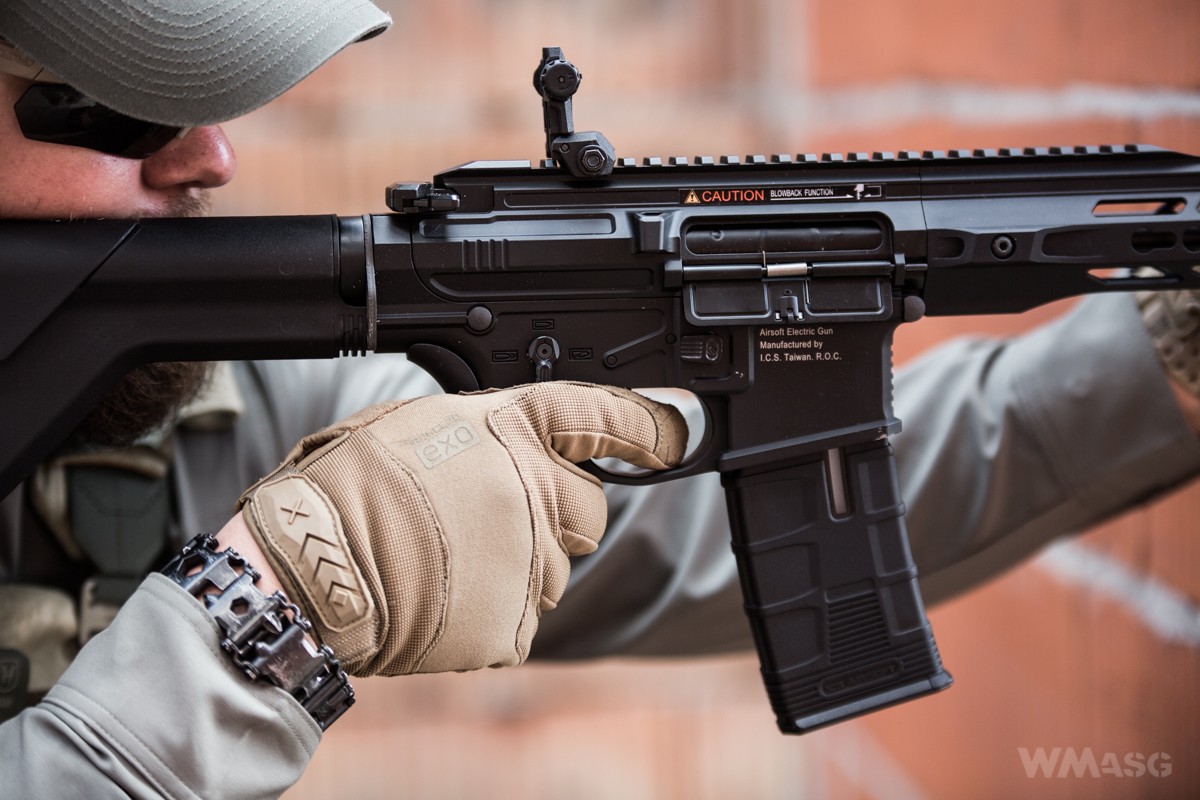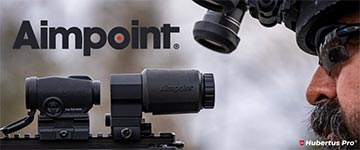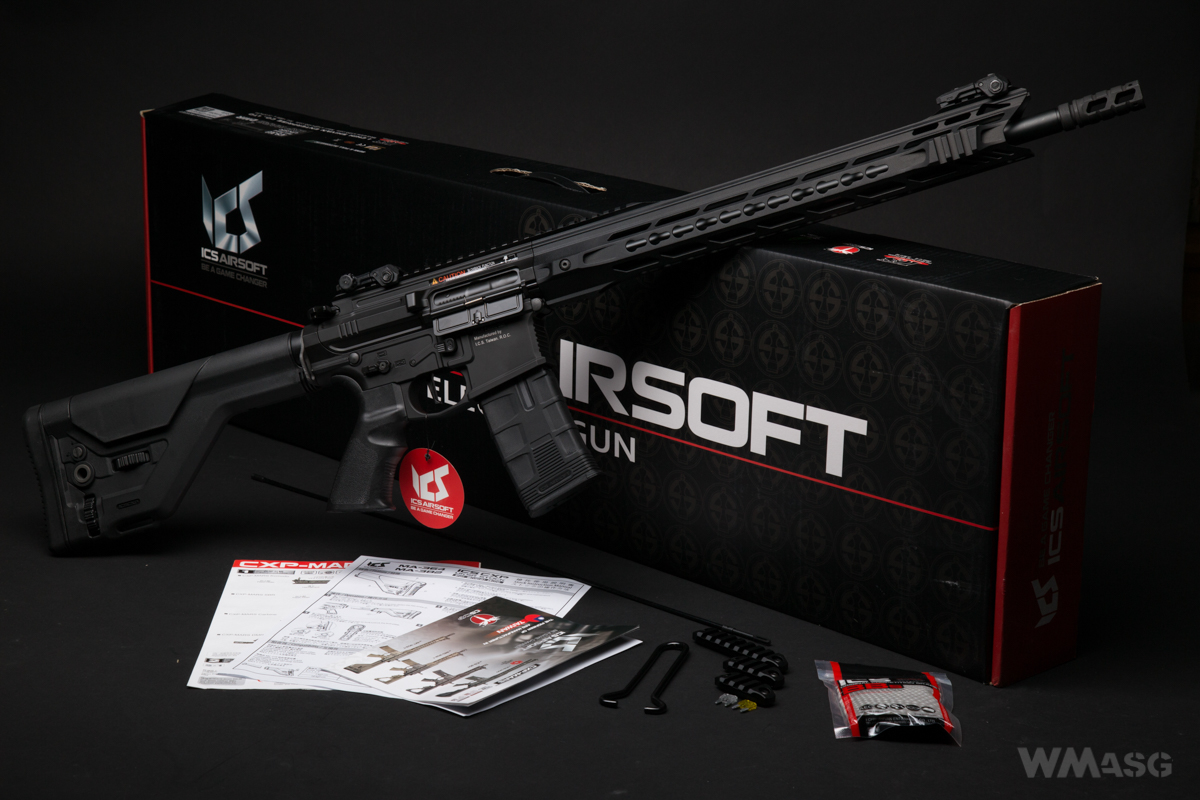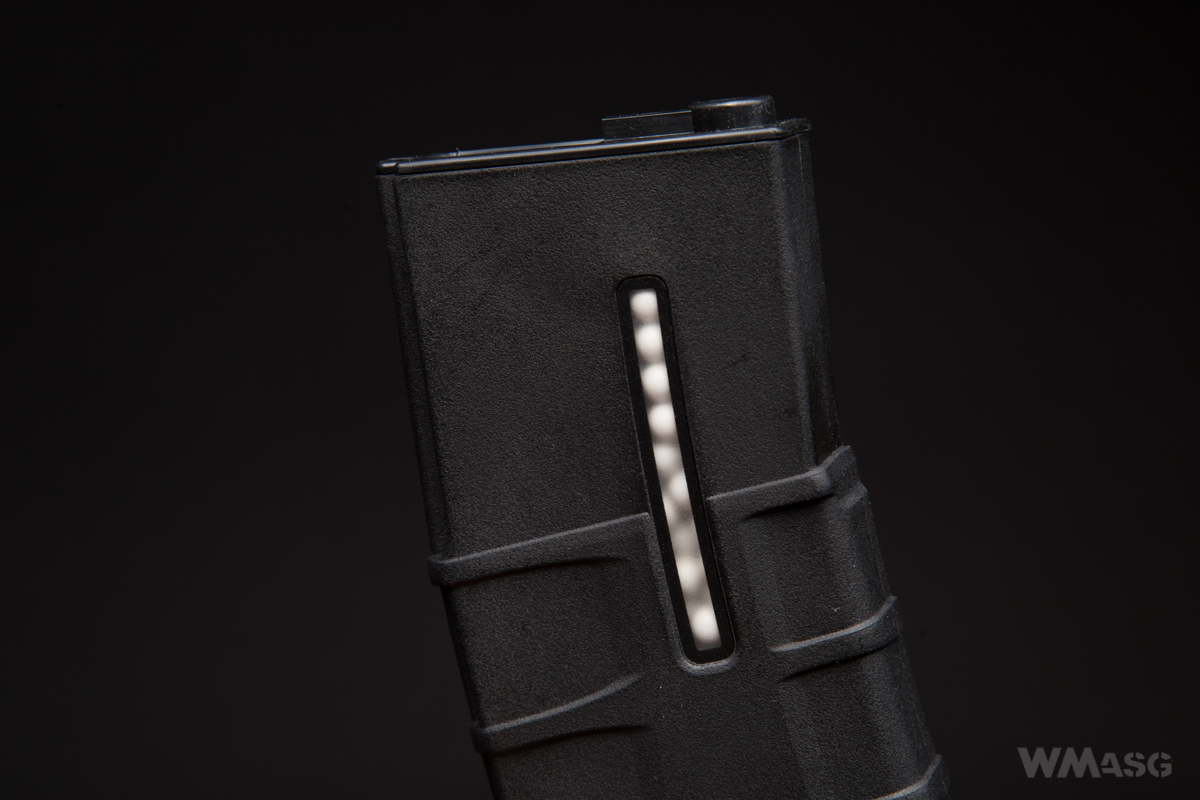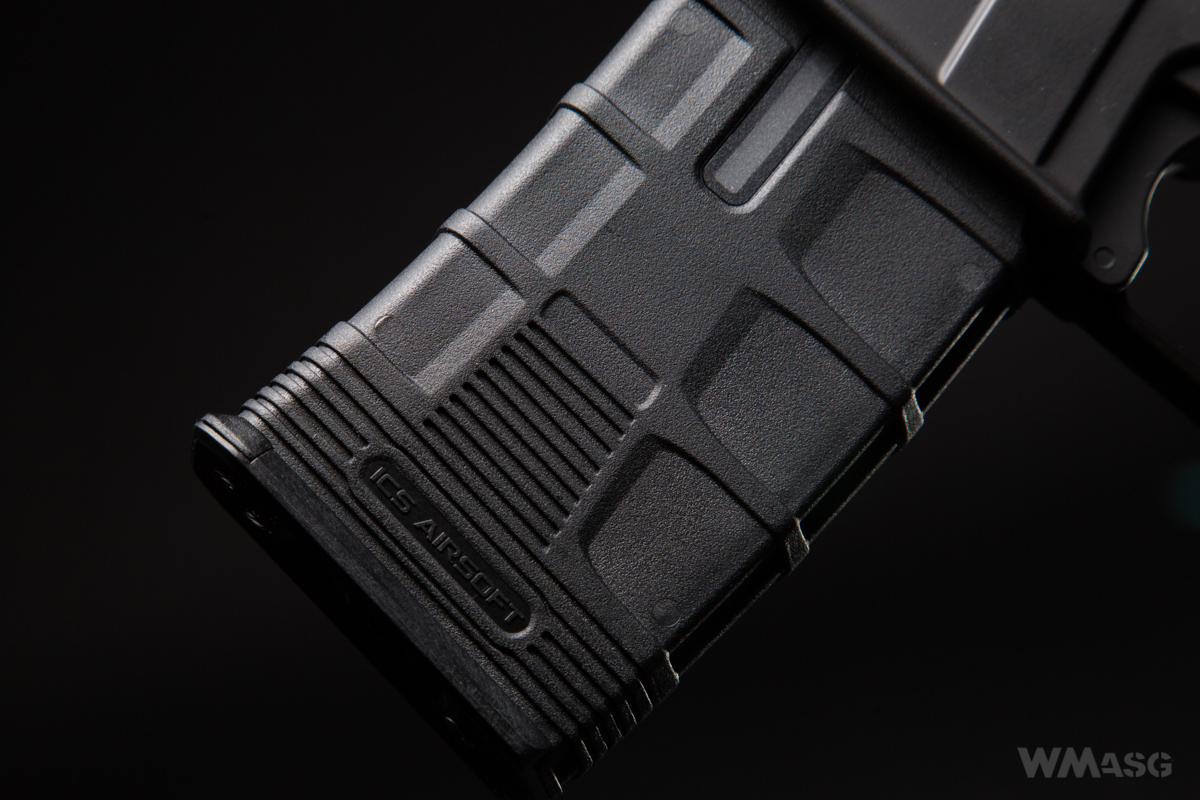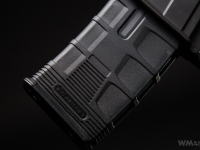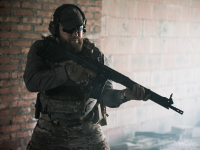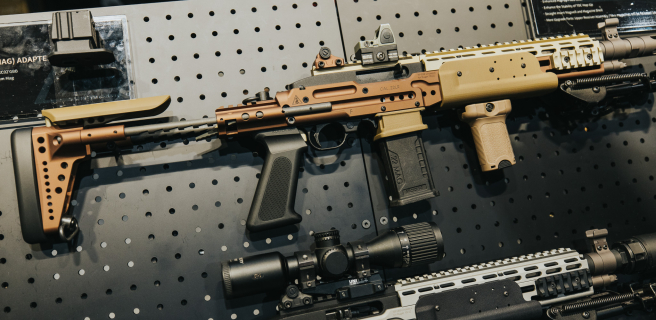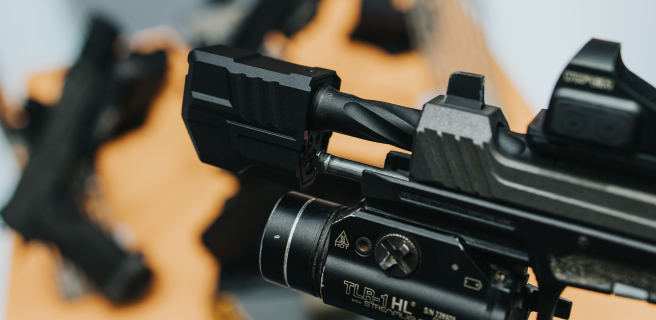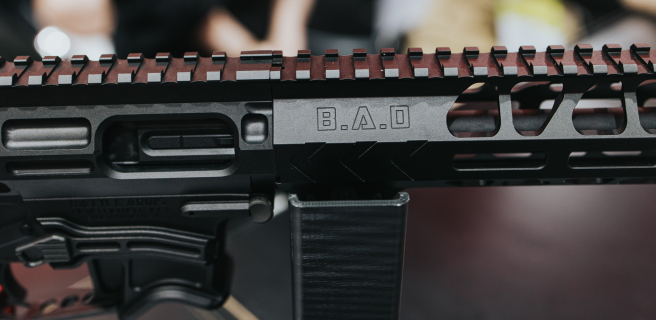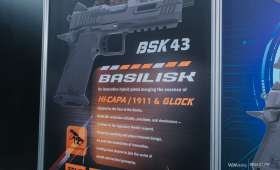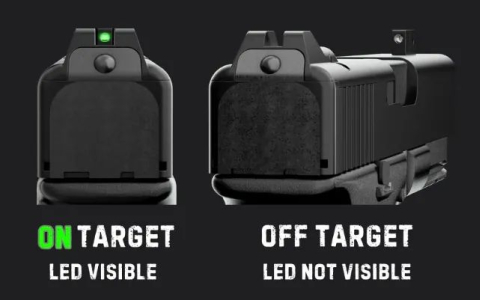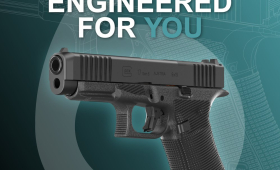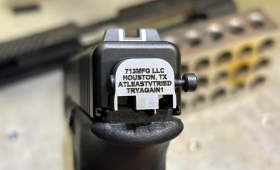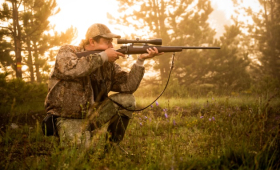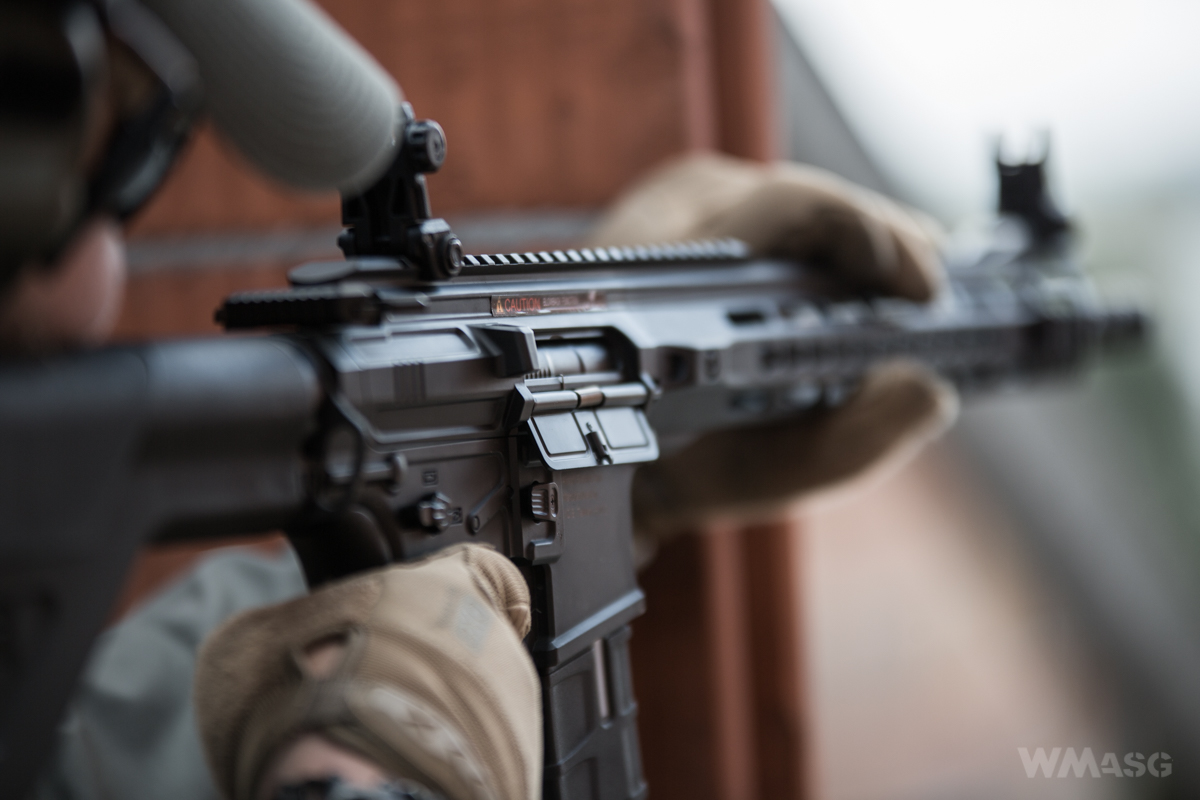
As a reminder, the CXP series consists of:
- CXP-MMR
- CXP-Peleador
- CXP-YAK
- CXP-MARS
- CXP-08
- CXP-15
- CXP-16
- CXP-APE
- CXP-HOG
- CXP-UK1
Within one series the differences between the models are small. The MARS series (according to the inscription on the magazine slot: Modern Assault Rifle System) consists of four carbines differing in the length of the barrel, the length and type of front and the buttstock. Each model is available with both a traditional trigger switch assembly and a simple MOSFET circuit (models with the ICS-30x code) as well as an advanced SSS (Self-diagnostic Shooting System) electronic control system (models with the ICS-30XS3 code). In addition, we have a choice of three color variants of each version: black, tan and two-color: black and tan. This gives a total of 24 versions to choose from.
The CXP-MARS
Series distinguishing features:
- modern-looking metal receivers that have been CNC machined
- ambidextrous manipulators
- metal fronts made in the Keymod system
- a spring release system
- an enlarged trigger guard
- an enlarged magazine release button.
Additionally, features also used in other ICS models:
- a two-part gearbox
- a quick spring change system
- mechanical blowback (EBB)
- electrical wiring with a simple MOSFET circuit
- folding CFS sights.
Differences between different MARS versions:
| SBR | Carbine | Comodo | DMR | |
| overall length | 705/800 | 810/905 | 840/935 | 980 |
| inner barrel length | 263 | 375 | 375 | 458 |
| weight | 2940 | 3040 | 3160 | 3610 |
| type of buttstock | MTR | MTR | MTR-S1 | UKSR |
What I have before me is the longest version, the CXP-MARS DMR (ICS-303) , it is black and has a traditional trigger switch assembly.
Packaging and first impression![]()
CXP carbines are packed in cardboard boxes that adequately protect them against any damage. Inside, there are plastic inserts molded into sockets for individual parts of the sets. The whole is covered with a foam sheet from the top.
Each set, apart from the replica, includes:
- a Hi-Cap magazine holding 300 BBs, which is visually similar to the PMAG magazines
- a key for the mounting ring of the front and the external barrel
- a plastic cleaning rod
- a small packet of BBs of unmarked weight
- 2 spare mini 20 A and 25 A fuses
- detailed instruction manual in English and Chinese
- instructions for adjusting the buttstock and installing the battery
- folded colored leaflet with the list of ICS replicas.
Similarly to the other CXP series replicas currently tested, the MARS DMR also makes an excellent impression. This is probably the standard in this series, the finish is semi-matt, uniformly black. The only parts with a distinctly different color are the pins connecting the two parts of the receiver and the two-sided mounting point for a the carrying sling located between the receiver and the guide of the butstock.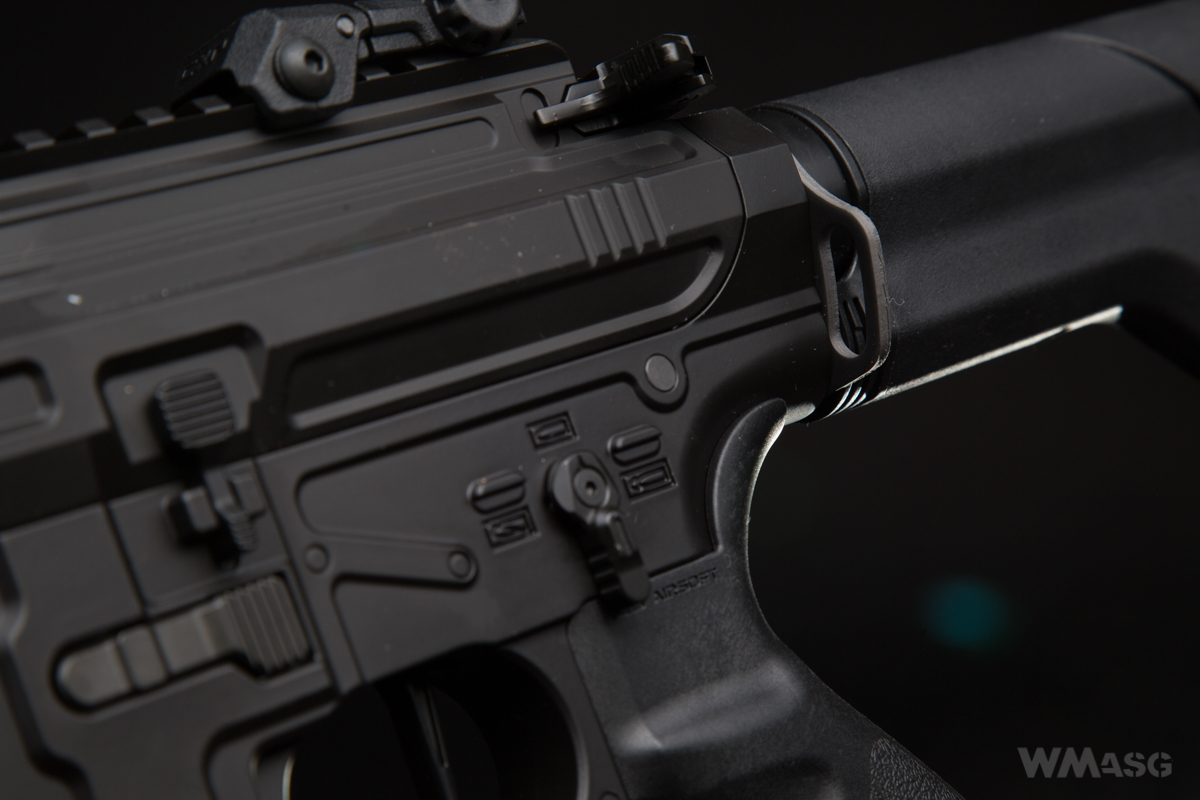
Unfortunately, just as in the other replicas, a slight clearance between the upper and lower receiver was a clearly visible the first time we took a look at the MARS. This results in a looseness revealed when holding the carbine in both hands an moving the hand holding the front to the left and right around the axis of the barrel. The defect is also present in the CXP-MMR and CXP-MARS models.
External parts
The receiver is made of aluminum alloy using digital machining (CNC). What primarily draws our attention is the matte black finish and a modern, aggressive shape. There are a lot of "reinforcements" and additional edges. All the markings, i.e. the name of the rifle, the serial number and the name of the manufacturer were laser engraved.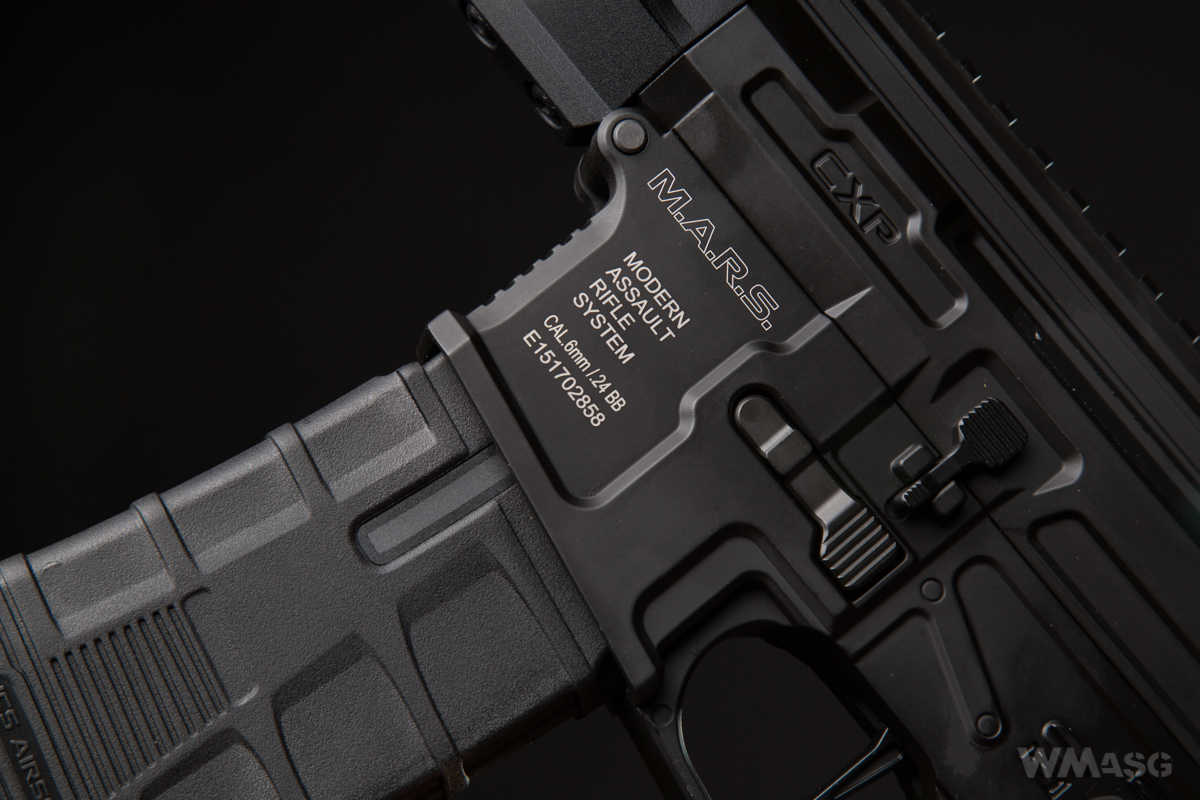
The upper receiver, just like modern sporting designs, is devoid of a forward assist, and the deflector seems to be slightly smaller.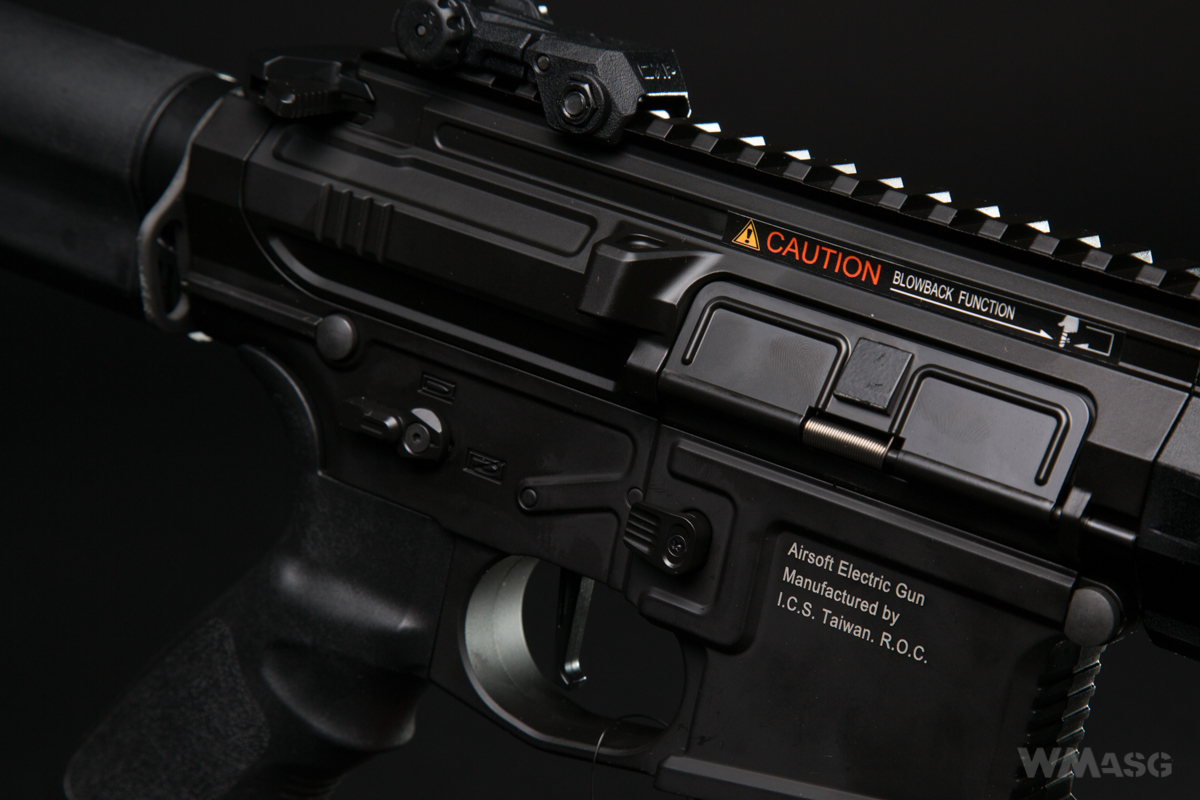 In the MARS, the issue of releasing a spring was solved differently. In the Peleadors and older replicas, it was done by pressing the forward assist. Here, in the absence of this device, this is done with a safety switch lever. When you set the replica to safe you also release the spring. It's just that our unit did not have this functionality. It should be there but its not. ICS explained to us that the our replica was made for the British market, and someone there asked for a version without the spring release system. Well ...
In the MARS, the issue of releasing a spring was solved differently. In the Peleadors and older replicas, it was done by pressing the forward assist. Here, in the absence of this device, this is done with a safety switch lever. When you set the replica to safe you also release the spring. It's just that our unit did not have this functionality. It should be there but its not. ICS explained to us that the our replica was made for the British market, and someone there asked for a version without the spring release system. Well ...
The trigger guard is fixed, integrated in the lower receiver. Its slightly arched shape provides more space around the trigger. The trigger itself is flat, straight, almost vertical. This is to increase the precision of the trigger and affect the accuracy of the shots.
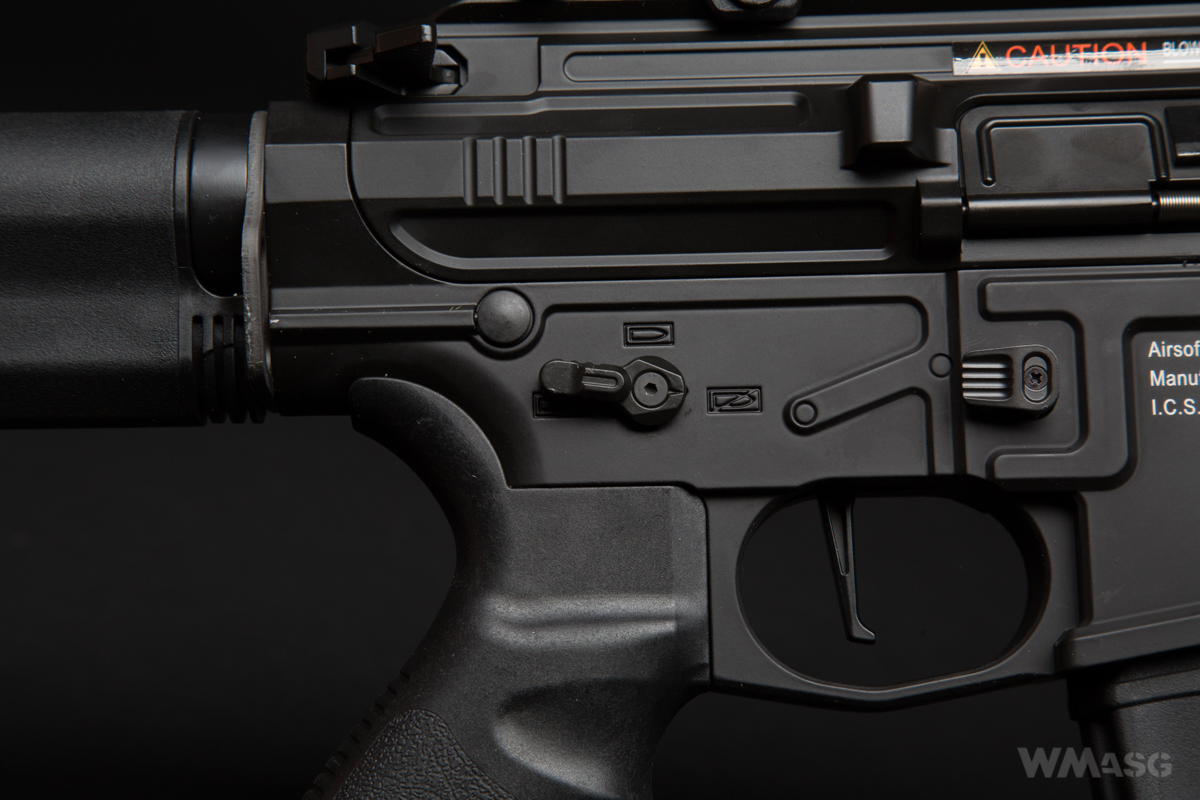 An important feature of the MARS series are enlarged double-sided manipulators. We have a safety selector on both sides, a magazine release button on both sides and a double-sided, enlarged latches of the charging handle.
An important feature of the MARS series are enlarged double-sided manipulators. We have a safety selector on both sides, a magazine release button on both sides and a double-sided, enlarged latches of the charging handle.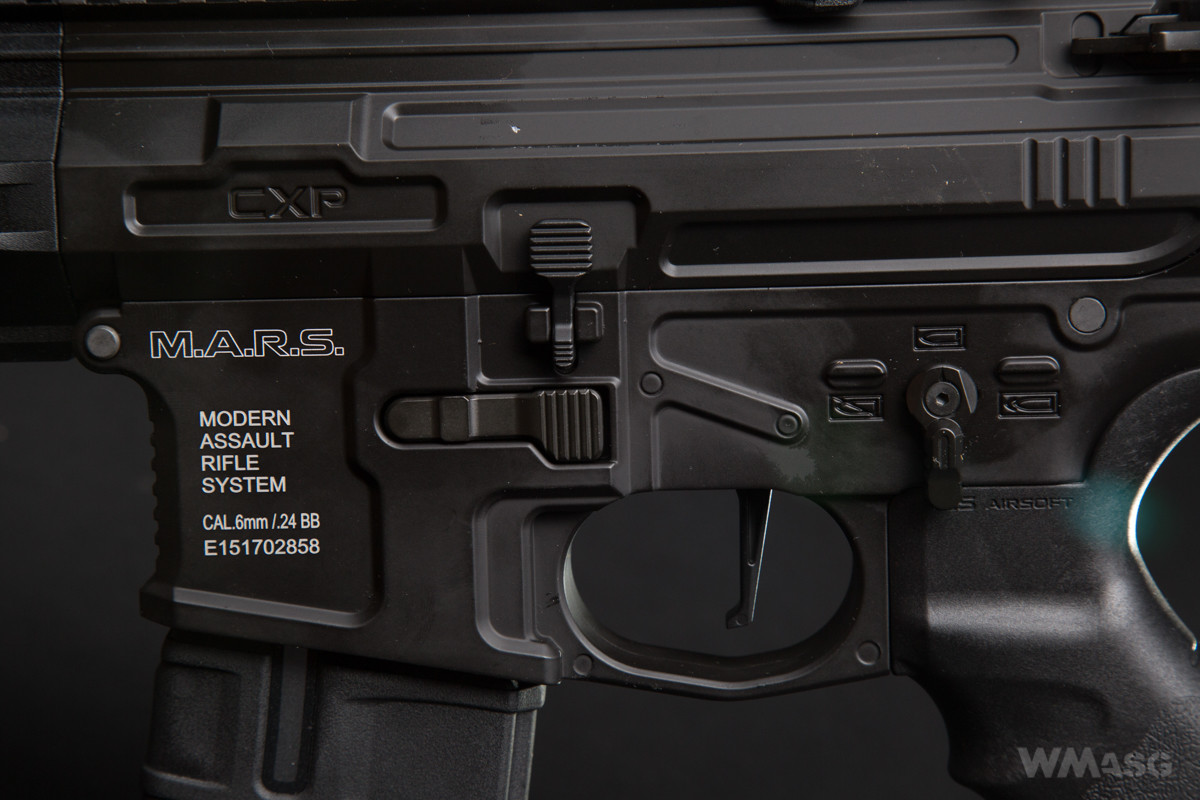 The carrying sling attachment ring between the receiver body and the buttstock is also double-sided.
The carrying sling attachment ring between the receiver body and the buttstock is also double-sided.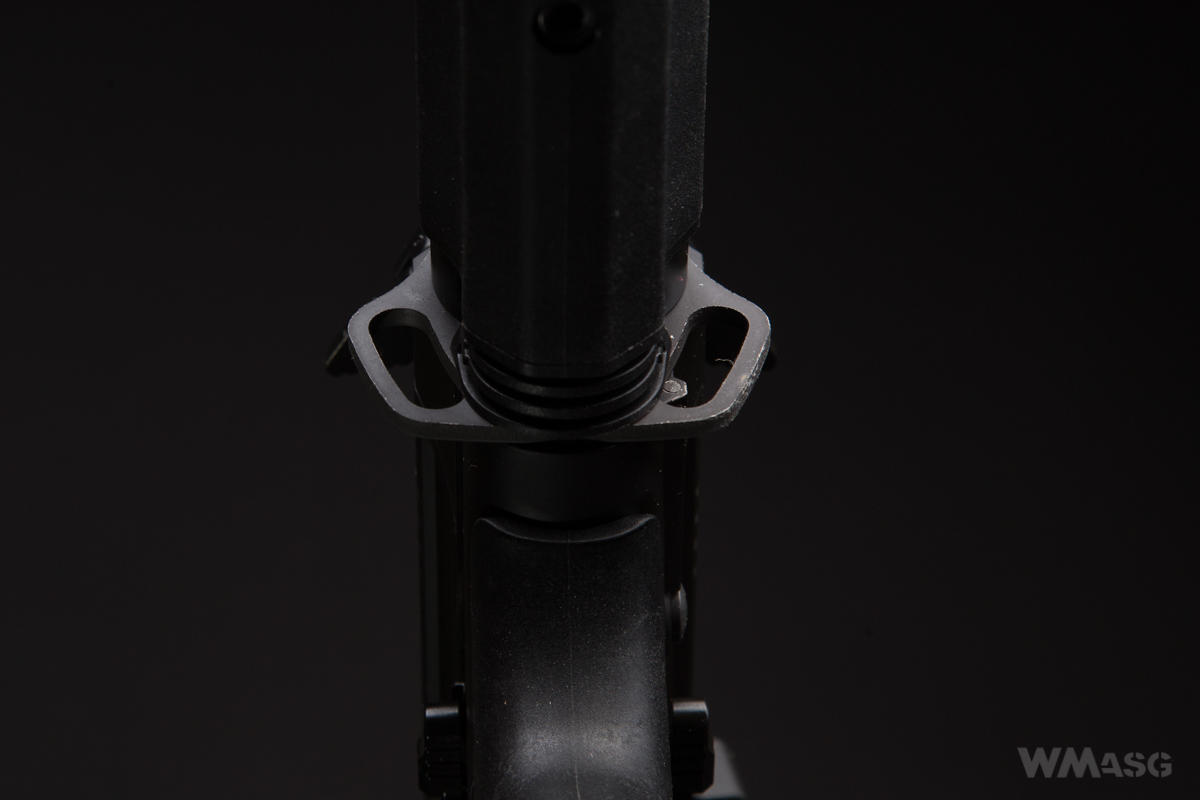
The enlarged magazine release button shown in the photos above works perfectly. Repeated attempts have shown that despite its simple form on both sides, it works very well.
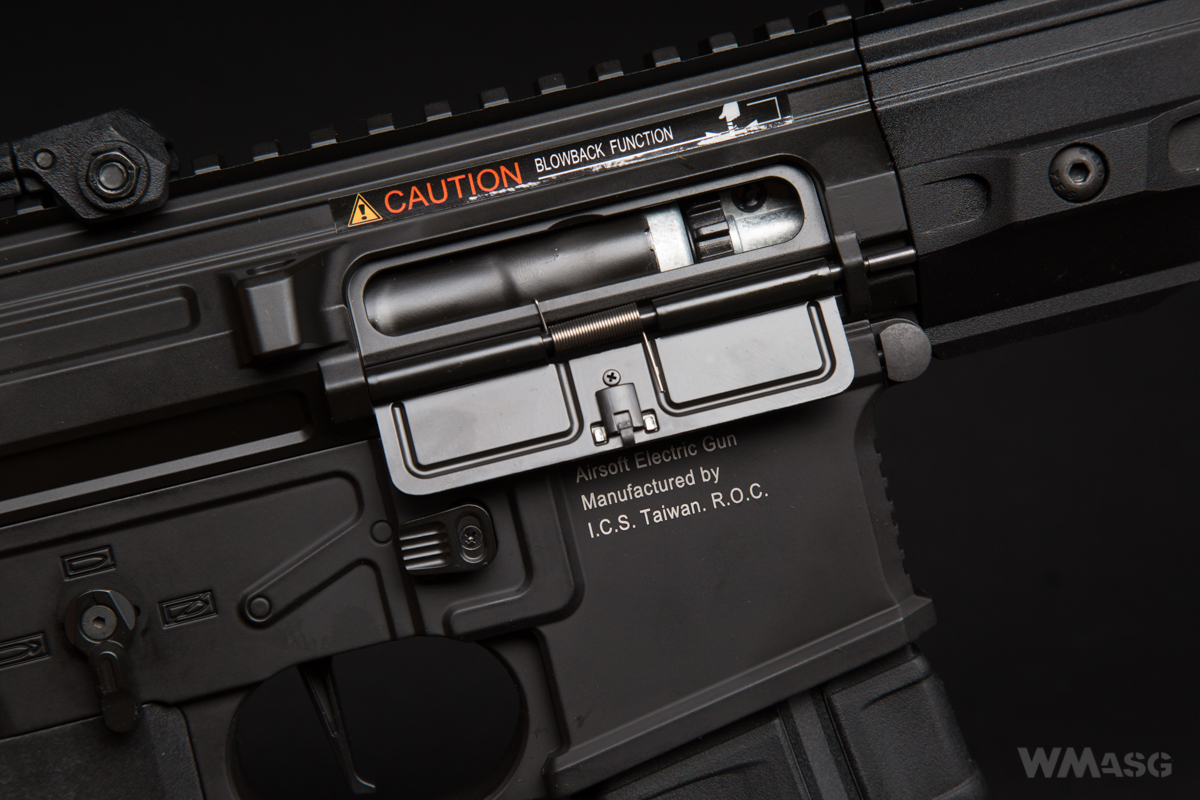
The ejector port cover opens after pulling the charging handle and stays open after releasing it, giving access to the HopUp adjustment. Unfortunately, the bolt carrier does not lock in the rear position. When making adjustment it is necessary to hold the charging handle back. While shooting, the bolt carrier moves together with the piston moving in the cylinder (EBB system).
The double-sided charging handle with enlarged latches.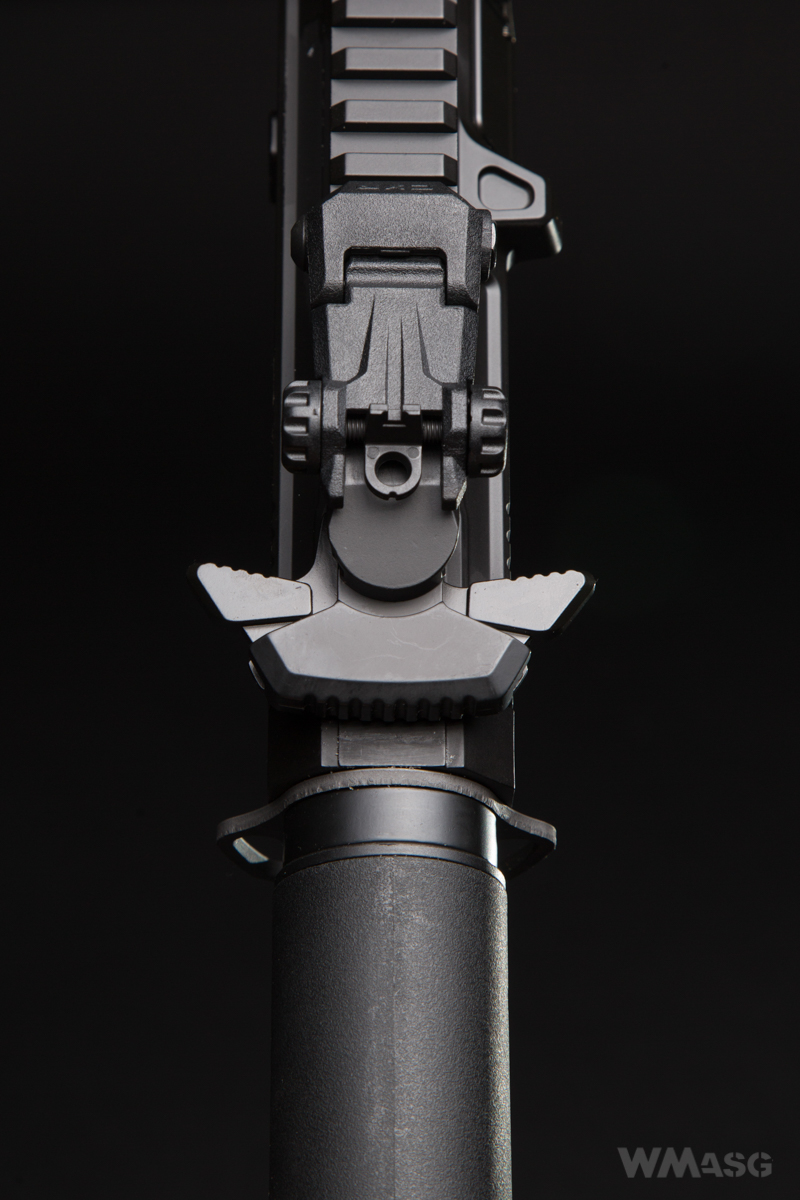
The carbine is distinguished by the pistol grip is uses. It is a grip from the so-called ergonomic group, profiled in a universal way, for right and left-handed shooters. The grip has a very distinct texture in the front and back. The bottom of the grip is ribbed, fully openwork for better motor cooling. There is no spacing washer. It has glued threaded brass sleeves for attaching the screws securing the bottom plate. The motor adjustment is done with a 4 mm Allen key.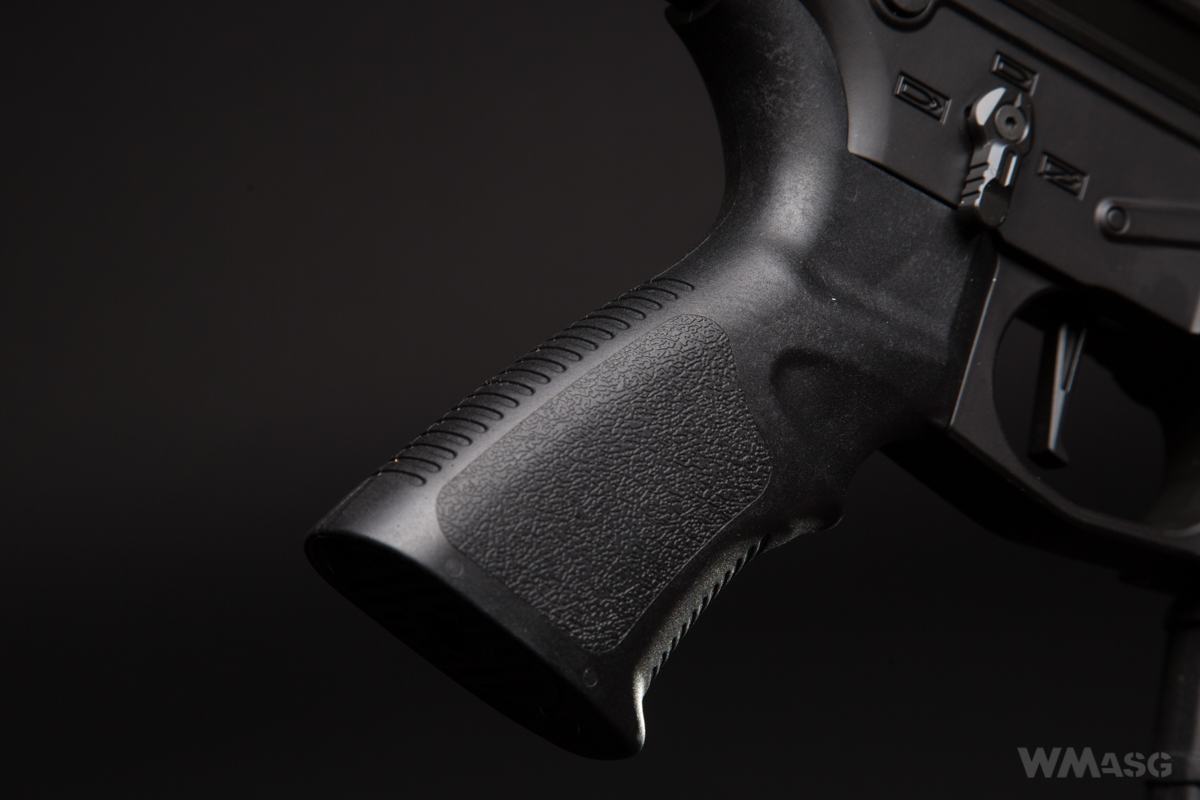
The front
The long and narrow front, made in the Keymod system, enables a secure grip and the possibility to arrange the hand according to individual preferences. It is made of aluminum alloy and painted black during the anodization process.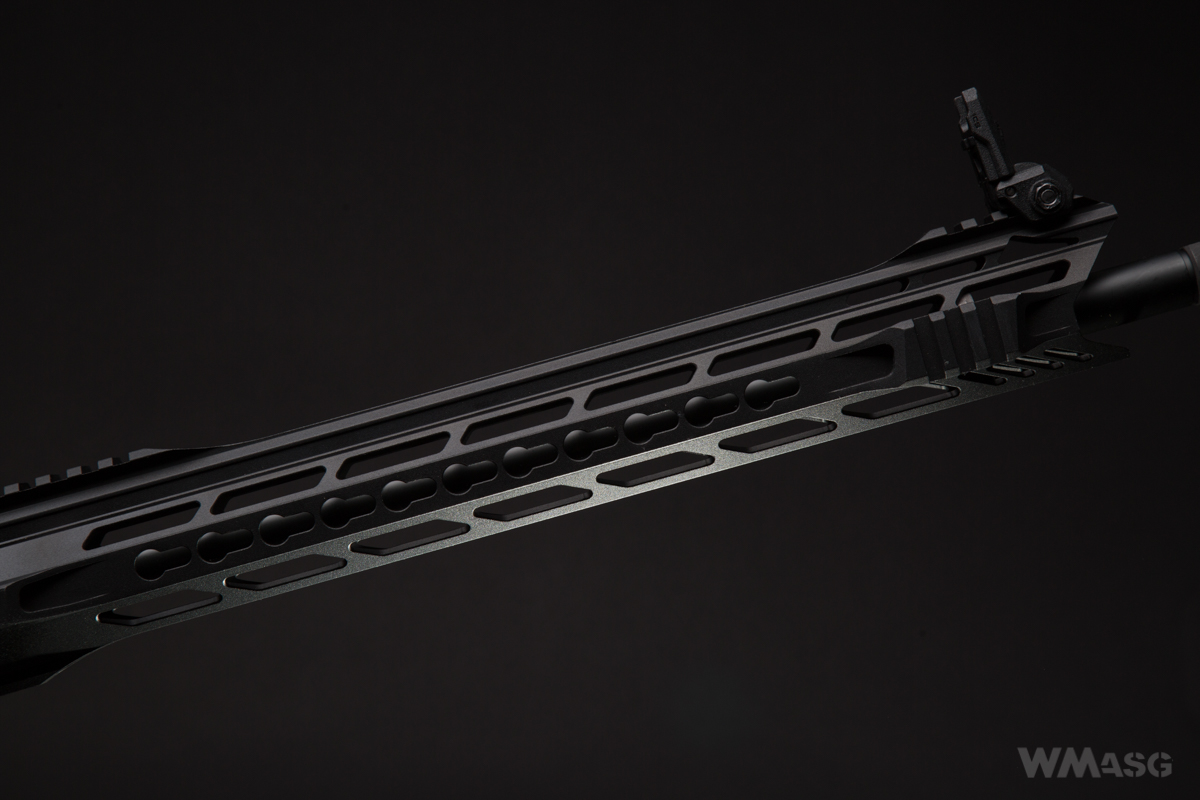 There are 11 Keymod system sockets on each side. There are 9 at the top and 16 at the bottom. In addition, from the side of the barrel exit, the front has 3 short Picatinny rails, 2 on the sides and 1 on the top. A front sight, which is part of the CFS folding sights kit, is mounted on the top rail.
There are 11 Keymod system sockets on each side. There are 9 at the top and 16 at the bottom. In addition, from the side of the barrel exit, the front has 3 short Picatinny rails, 2 on the sides and 1 on the top. A front sight, which is part of the CFS folding sights kit, is mounted on the top rail.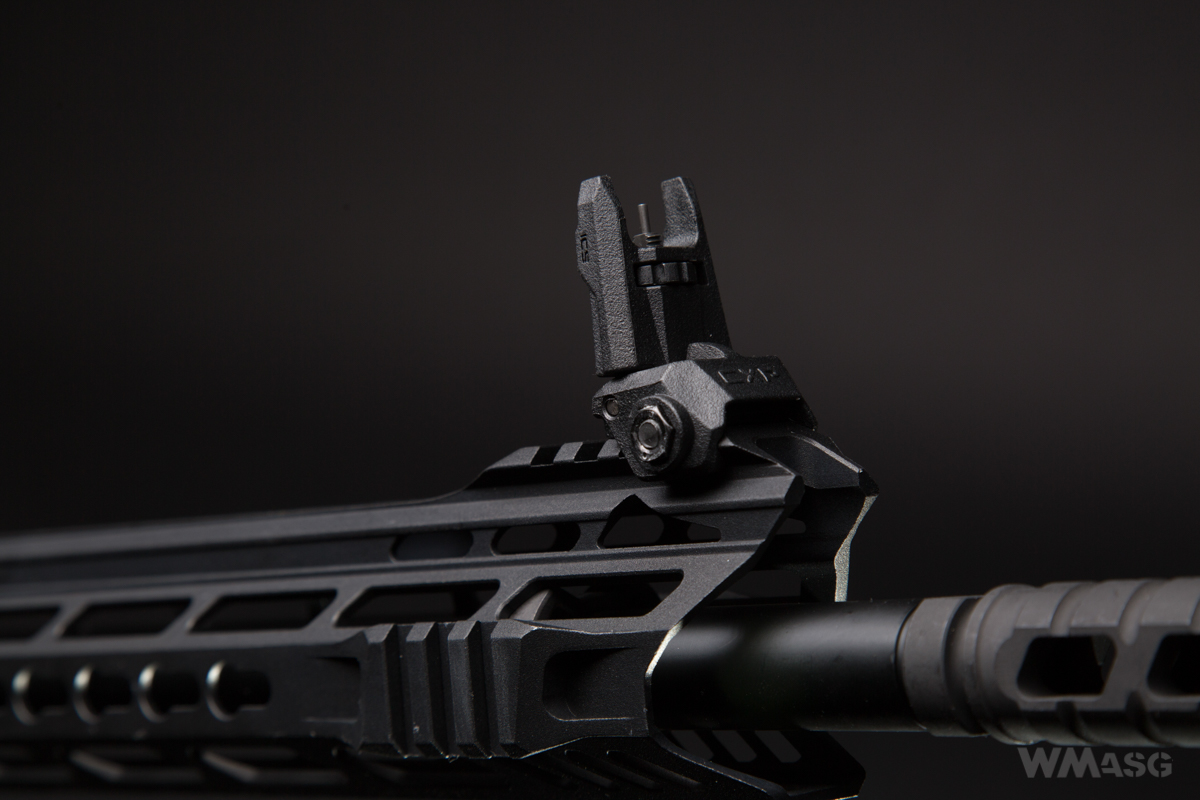 From the side of the receiver, the front has another Picatinny rain, which seamlessly connects with the one at the top of the upper receiver.
From the side of the receiver, the front has another Picatinny rain, which seamlessly connects with the one at the top of the upper receiver.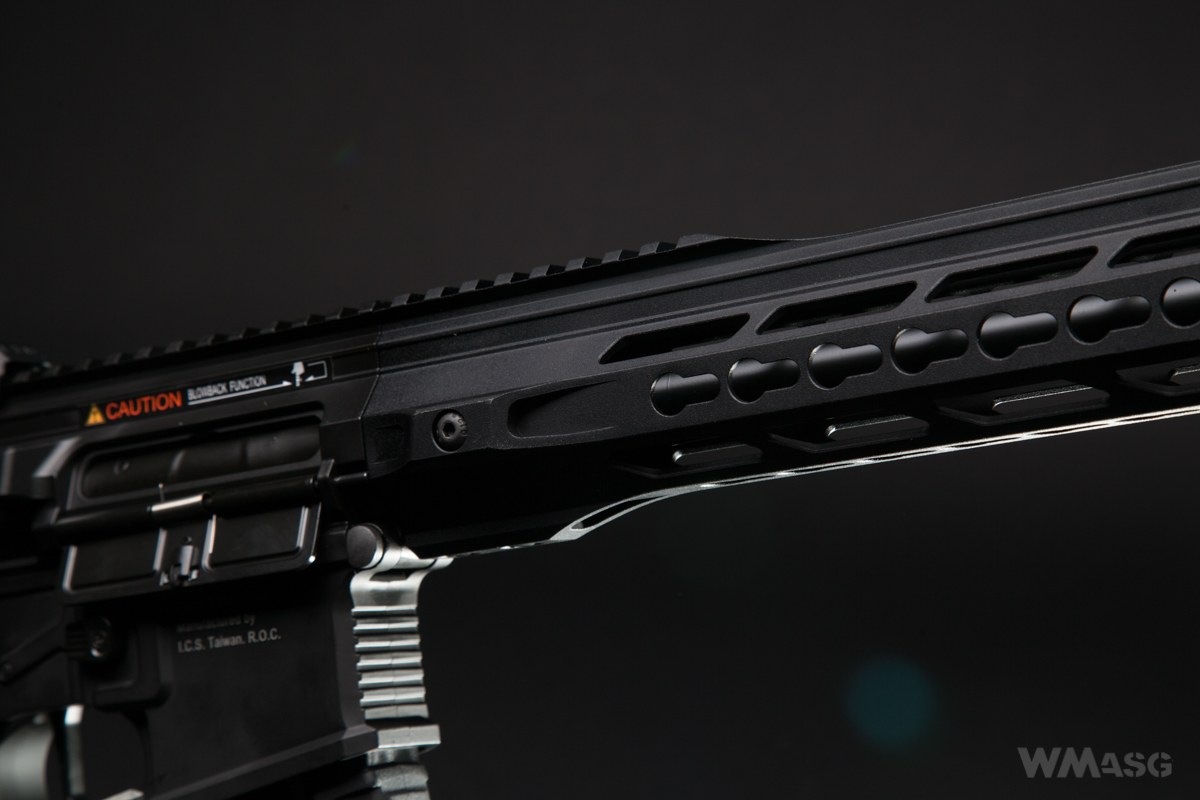
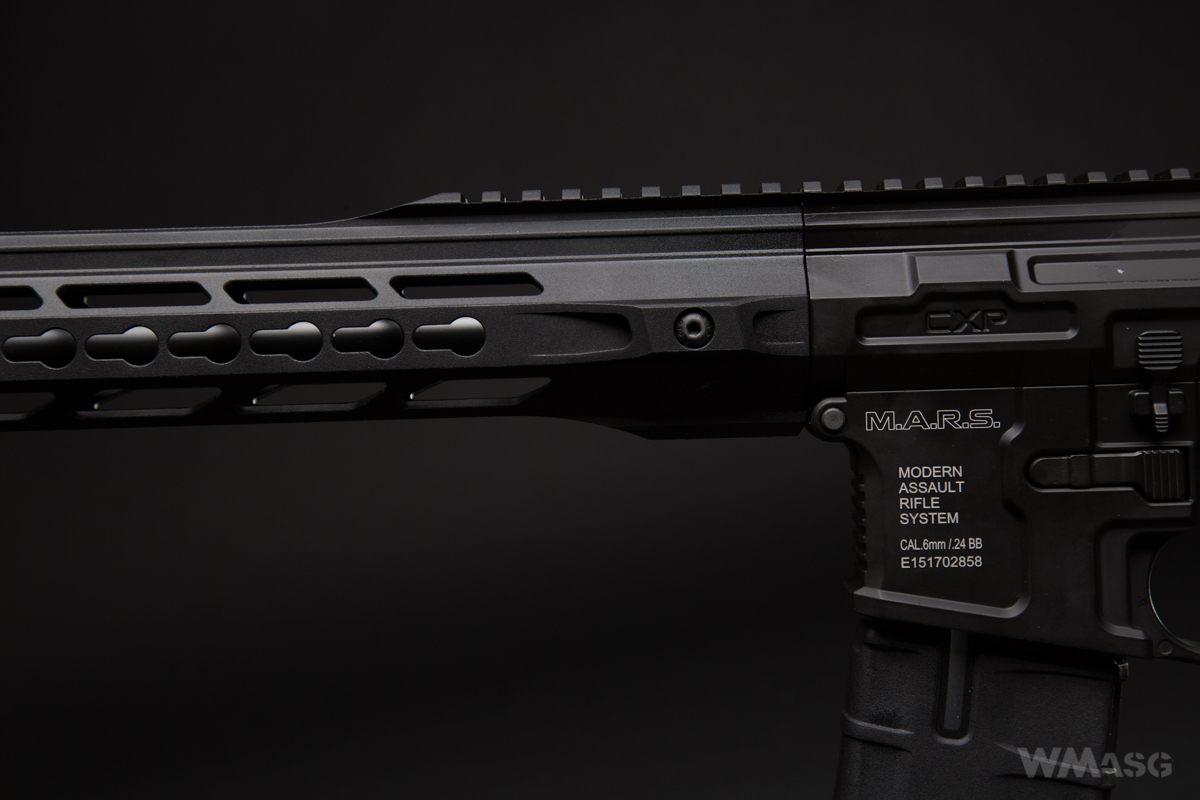 Under the front, there is no dummy block or gas tube mounted on the outer barrel.
Under the front, there is no dummy block or gas tube mounted on the outer barrel.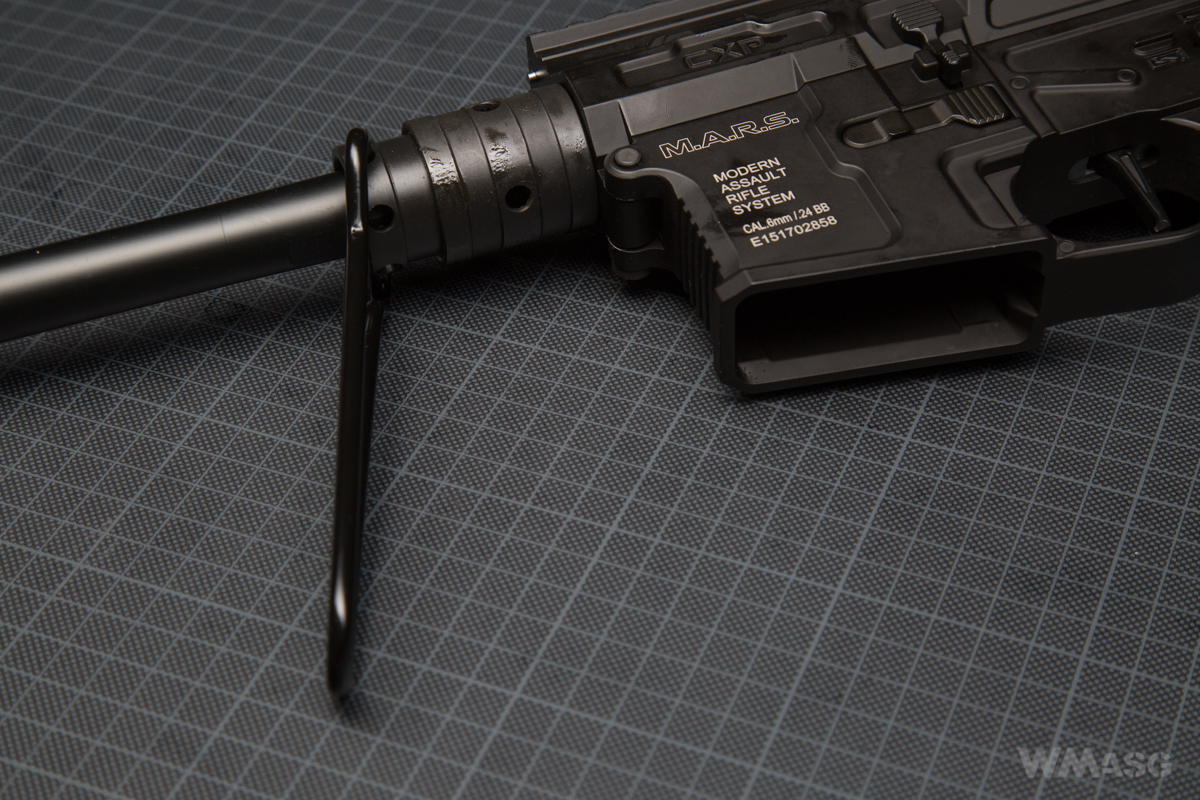 The barrel itself consists of 2 parts. It is finished with an muzzle brake called the Raider with a counterclockwise 14 mm thread, additionally secured with a 1.5 mm setting screw.
The barrel itself consists of 2 parts. It is finished with an muzzle brake called the Raider with a counterclockwise 14 mm thread, additionally secured with a 1.5 mm setting screw.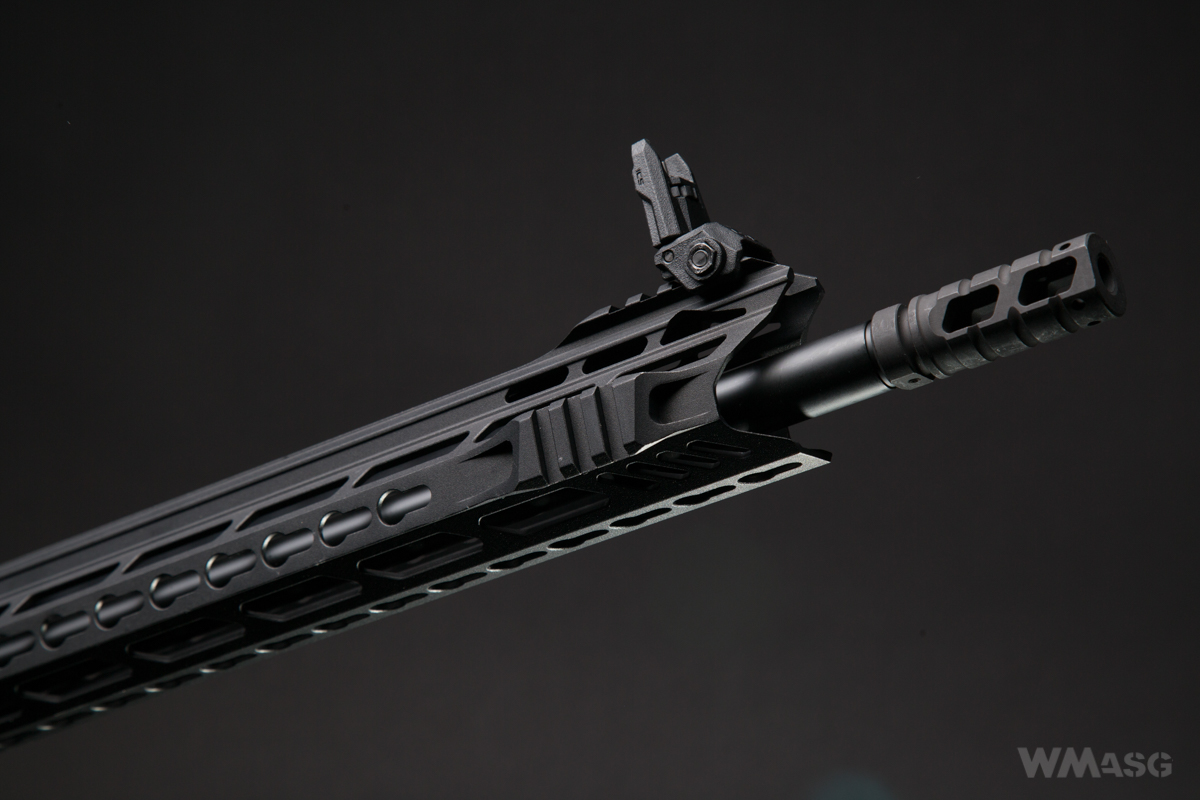
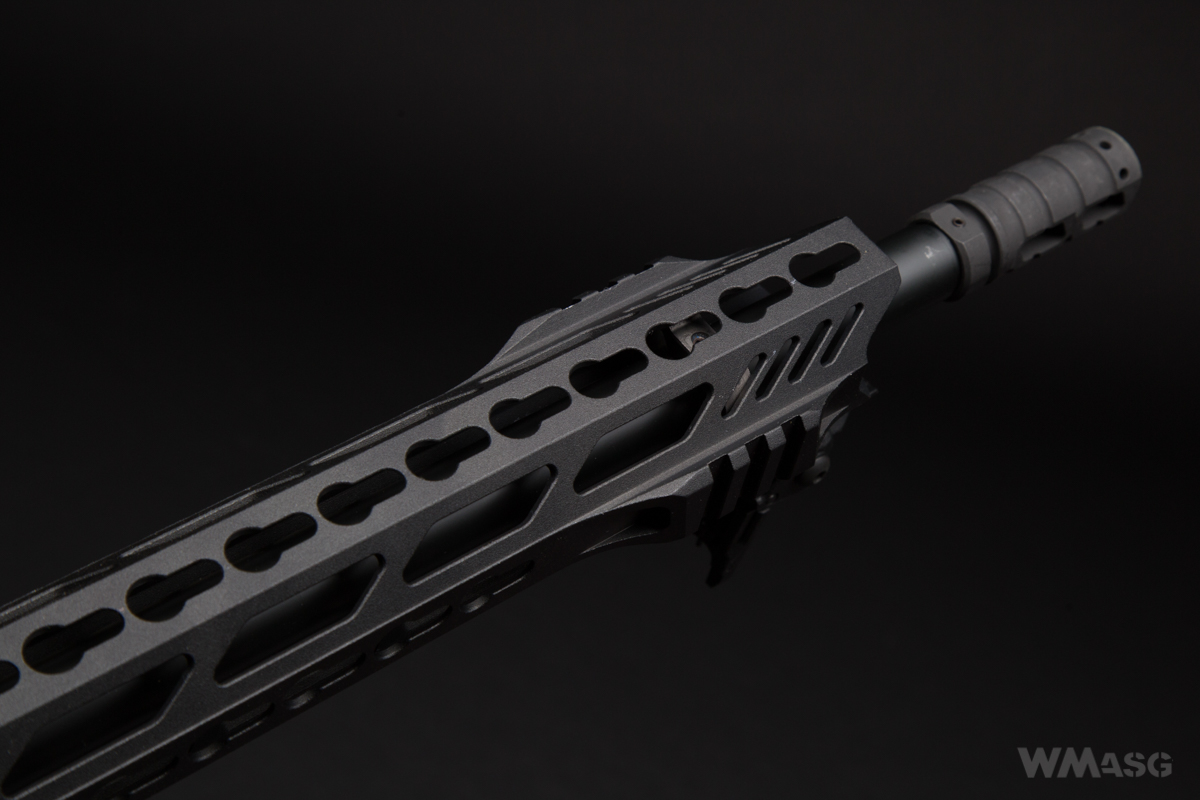
The sights
The CFS sights are made of plastic. They can be used both in the folded position, than the front sight cannot be adjusted, and raised position, then the front sight can be adjusted vertically, the the rear sight horizontally.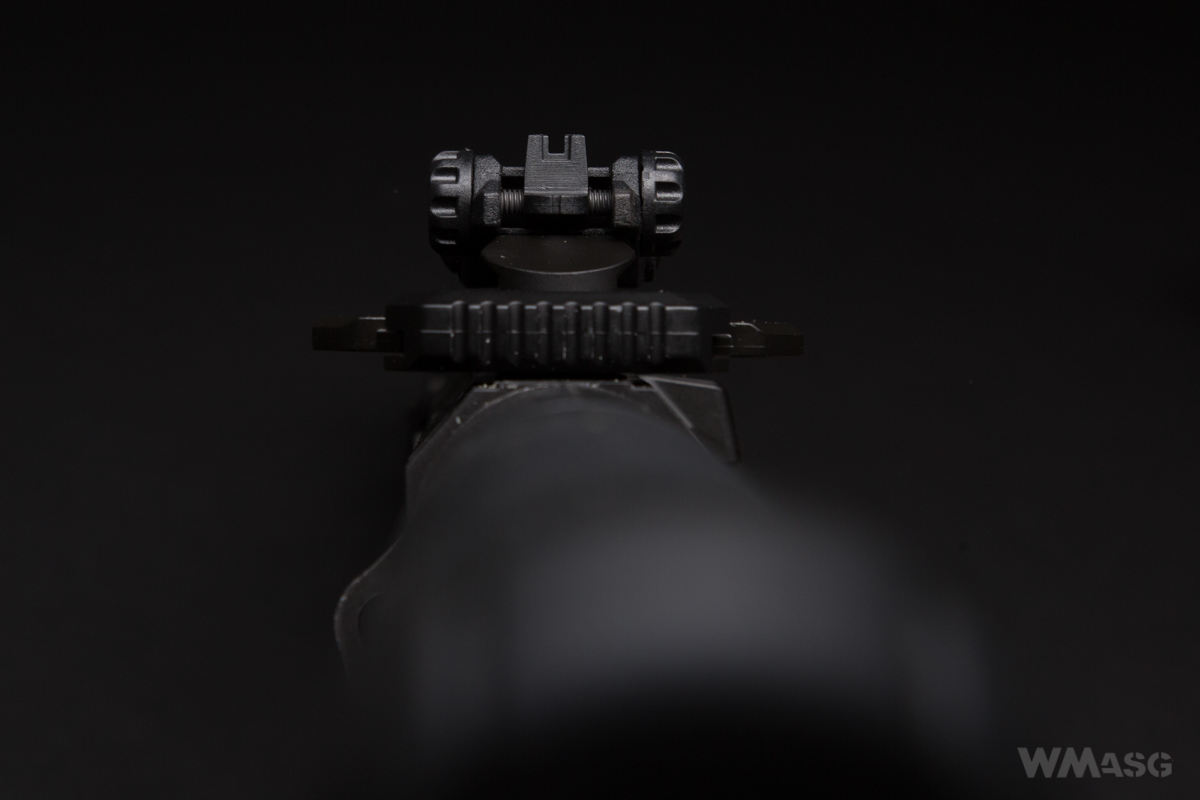
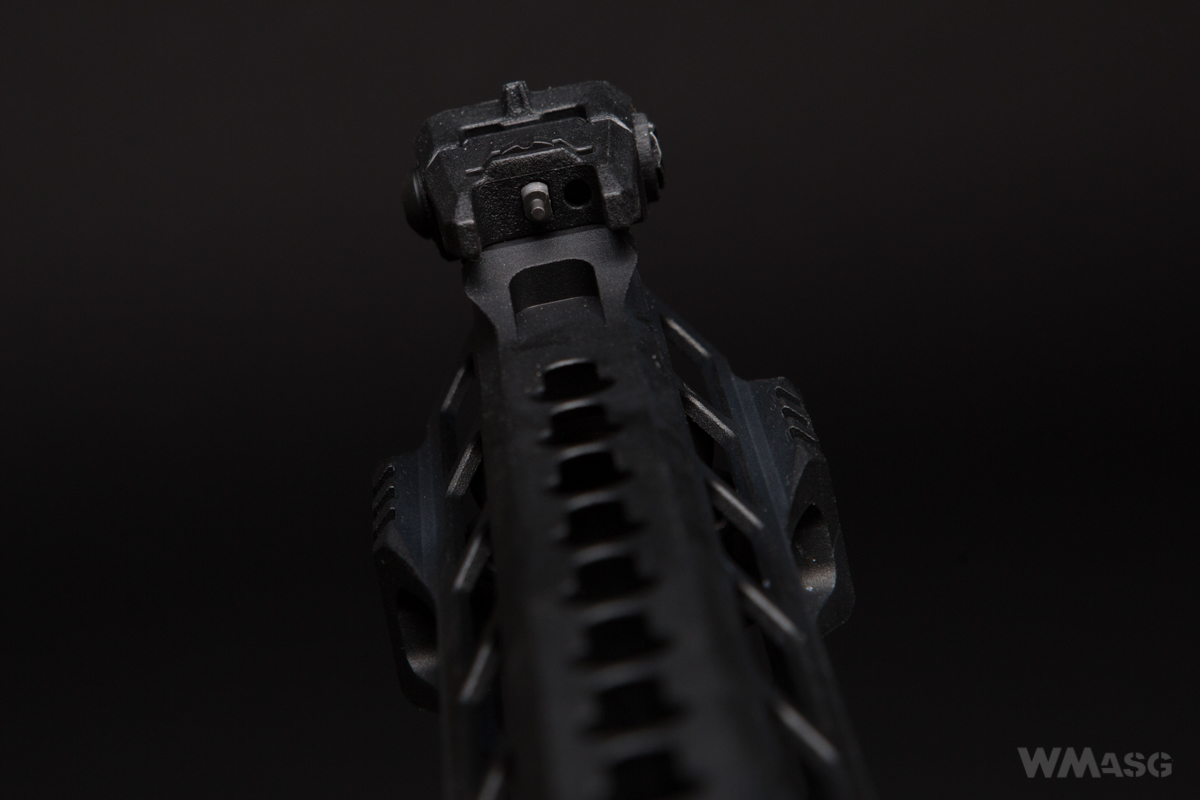
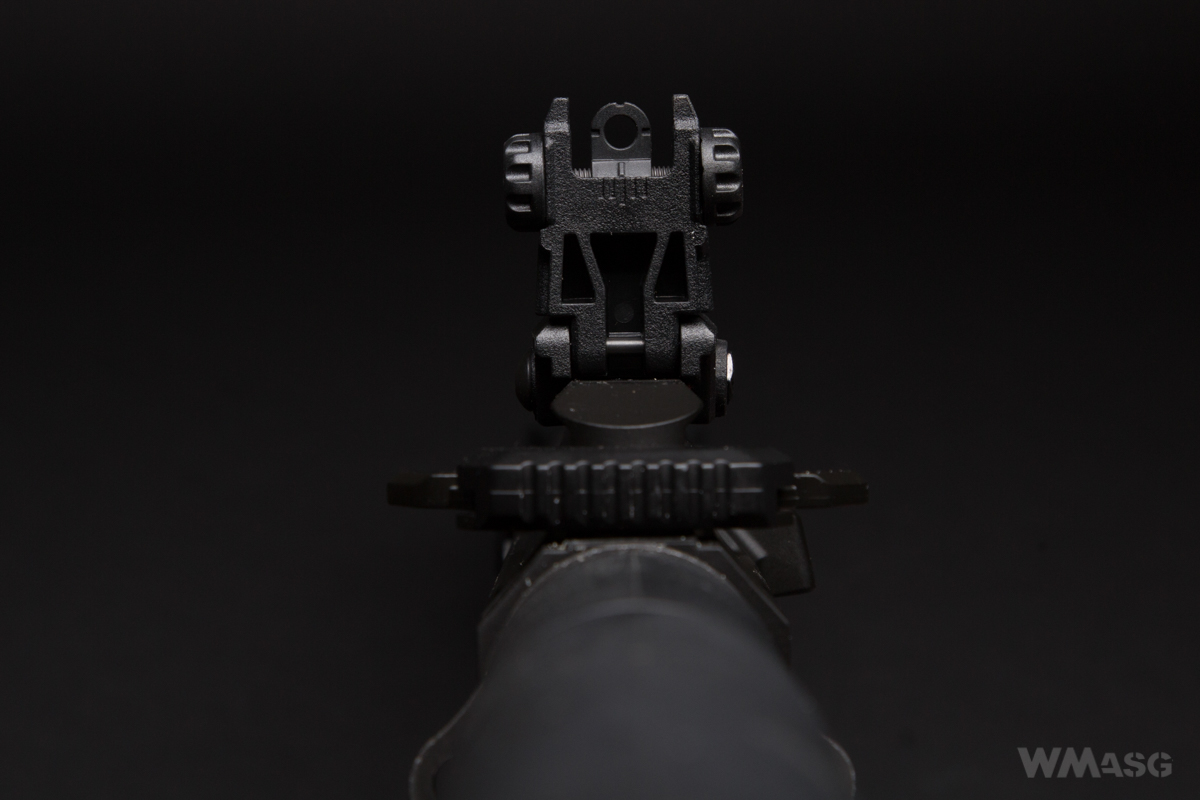
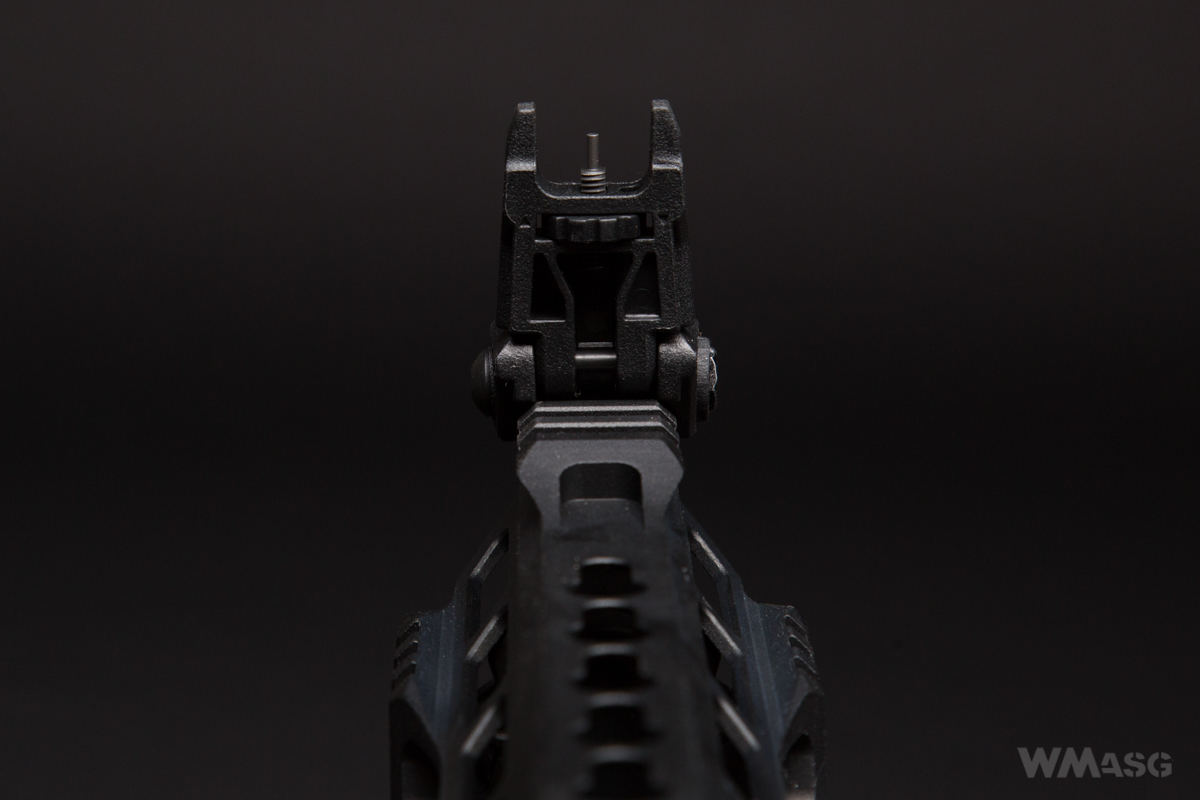
The sights are lifted by hand and once risen, they hold tight and do not shake. They are adjustable with comfortable knobs and do not require the use of any tools. They are mounted on Picatinny rails by sliding them on and securing with 3 mm allen screws.
The buttstock
For those who want to treat this replica like a DMR rifle, the multi-position stock, called by ICS the UKSR sniper buttstock, may be interesting.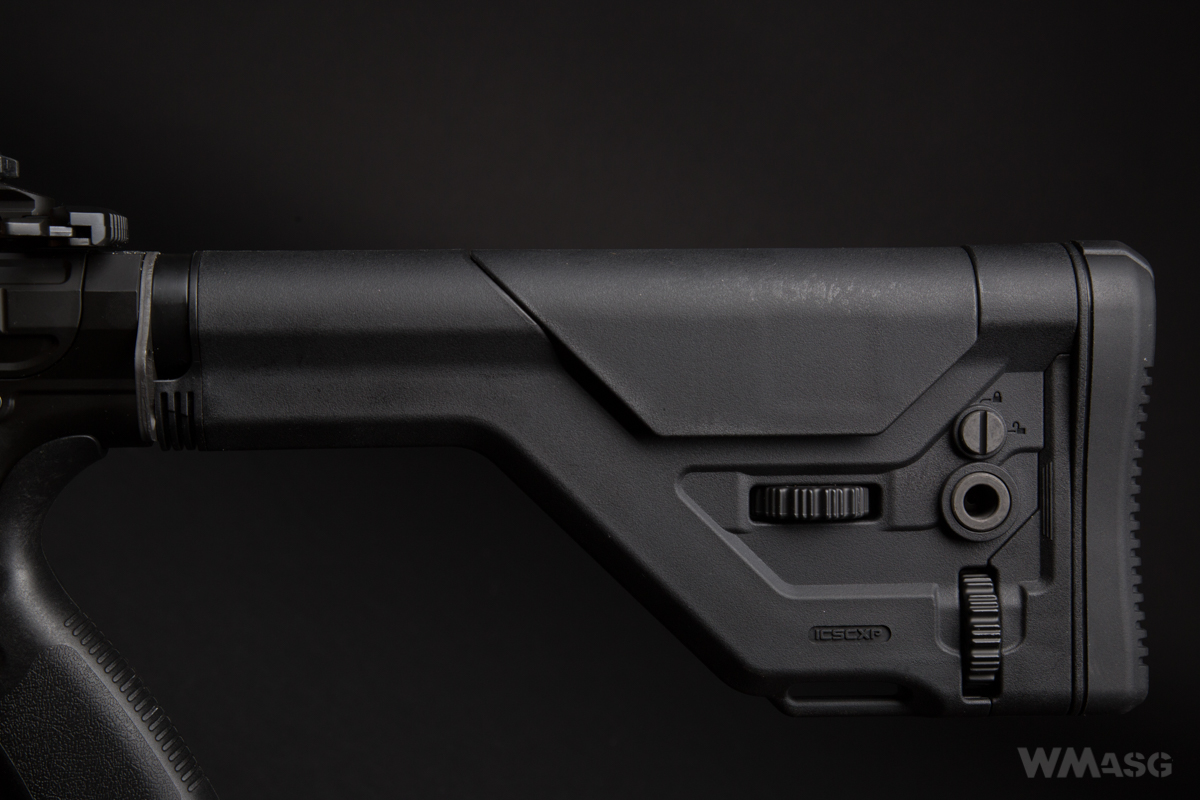 The buttstock is equipped with a smooth cheek pad with an adjustable height and an adjustable rubberized back plate. Both adjustments are made with screws. The adjustment range of the back plate is 3 cm, and the maximum height of the cheek pad is 2 cm. The cheek pad has no limiters and when risen too high it will drop down. Luckily, markers on both sides warn us when we approach the height limit as they become visible after reaching the maximum safe position.
The buttstock is equipped with a smooth cheek pad with an adjustable height and an adjustable rubberized back plate. Both adjustments are made with screws. The adjustment range of the back plate is 3 cm, and the maximum height of the cheek pad is 2 cm. The cheek pad has no limiters and when risen too high it will drop down. Luckily, markers on both sides warn us when we approach the height limit as they become visible after reaching the maximum safe position.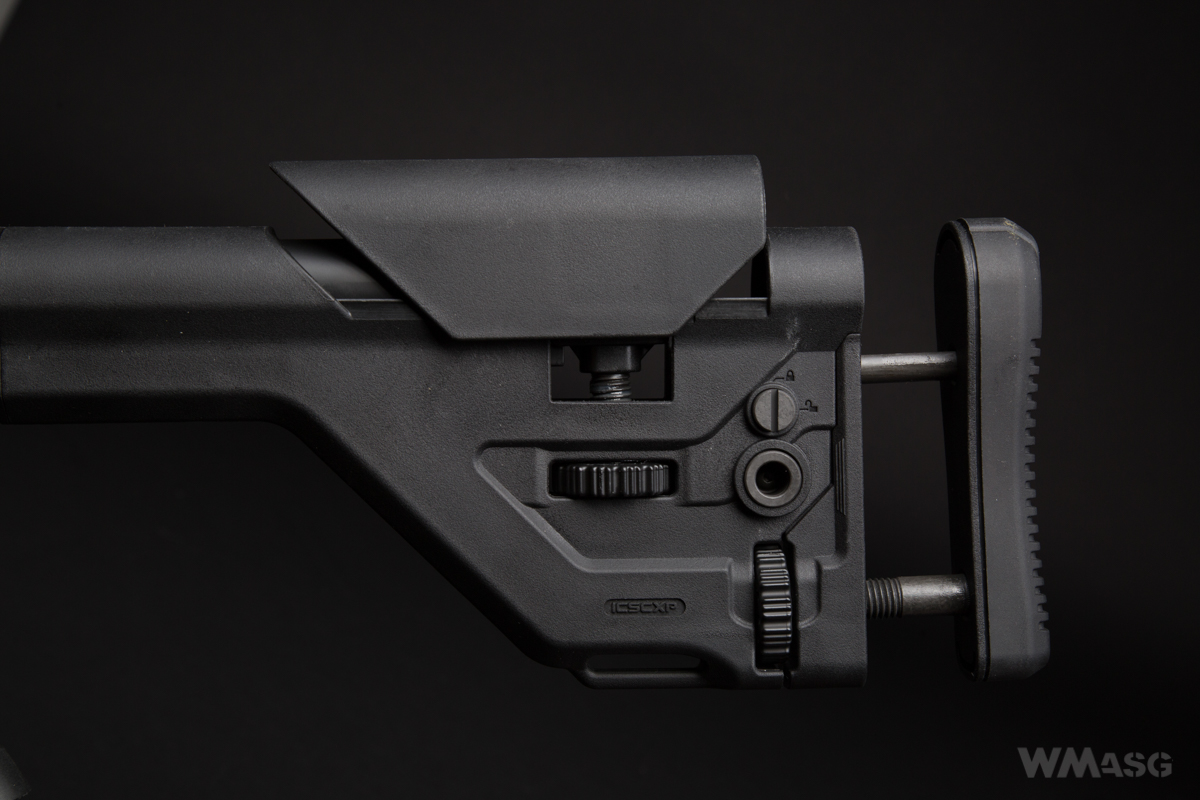
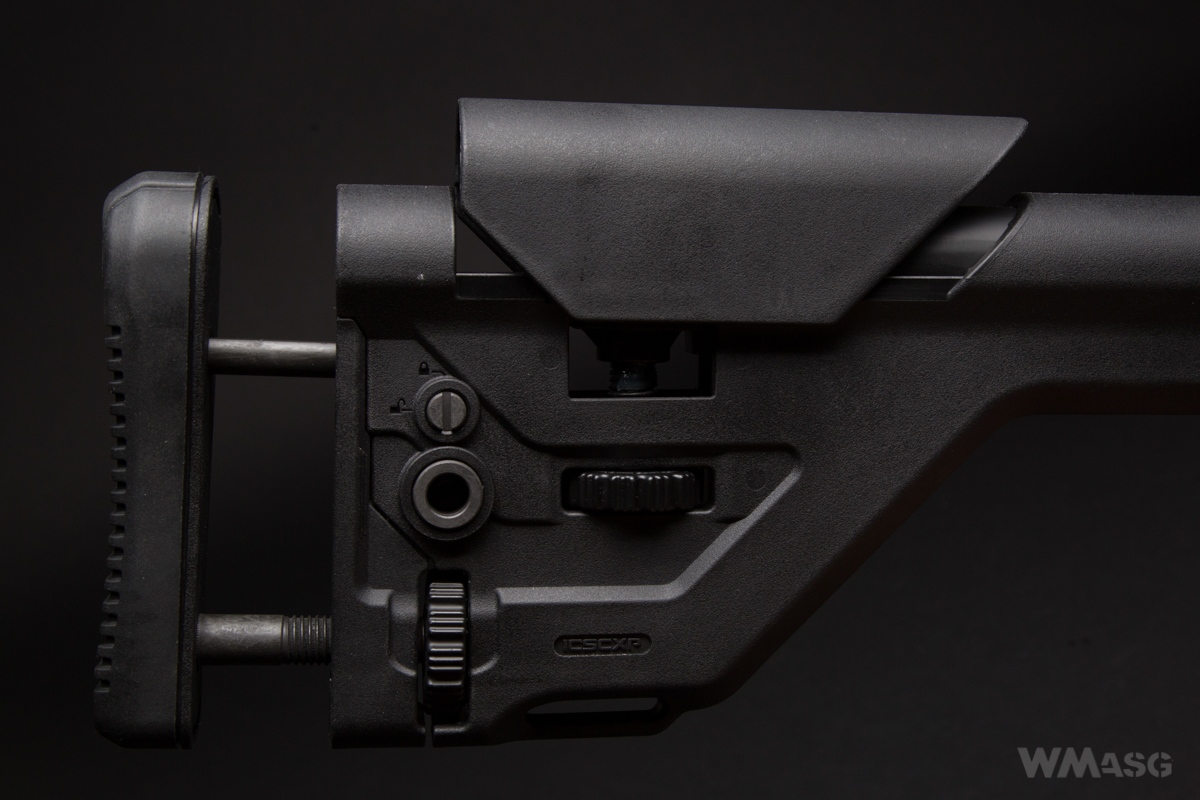
The buttstock has one more adjustment (extension) method that is invisible at first glance. Well, it turns out that the seemingly fixed buttstock is mounted on a standard telescopic buttstock guide.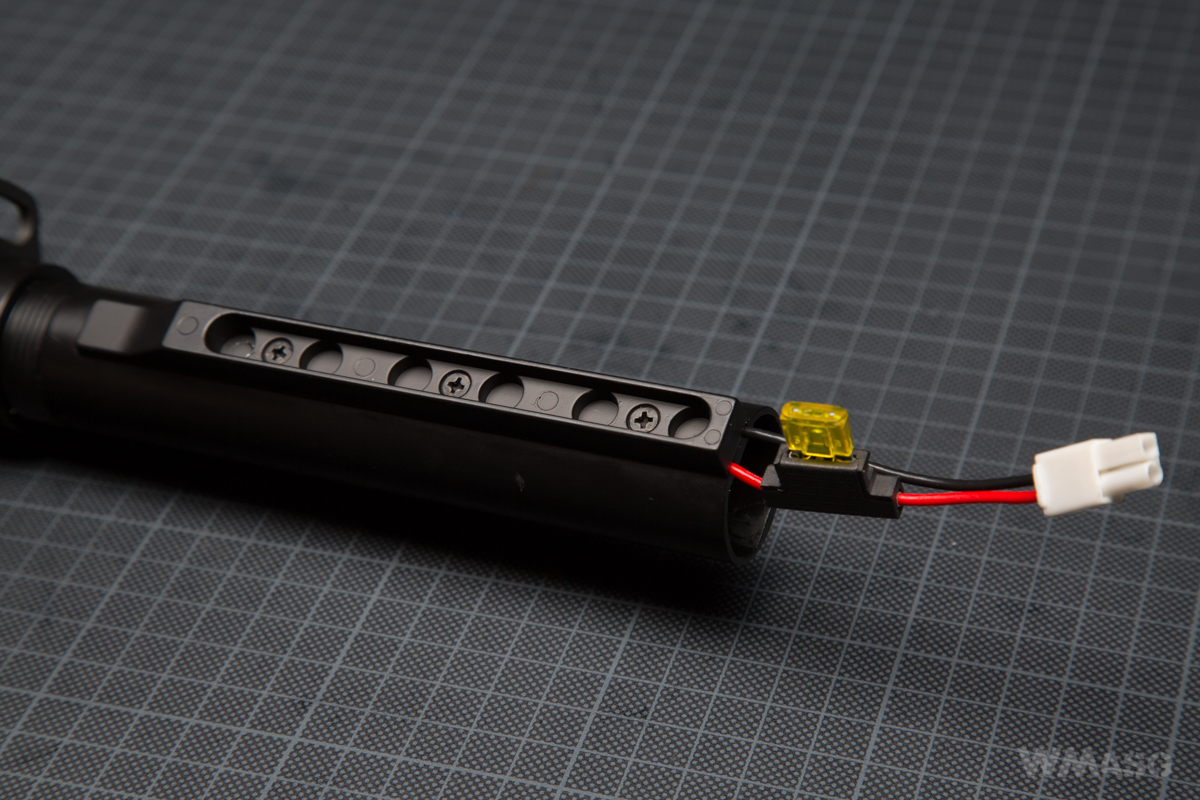 It is a guide equipped with a clever system of safe wire routing, which ICS also uses in other replicas.
It is a guide equipped with a clever system of safe wire routing, which ICS also uses in other replicas.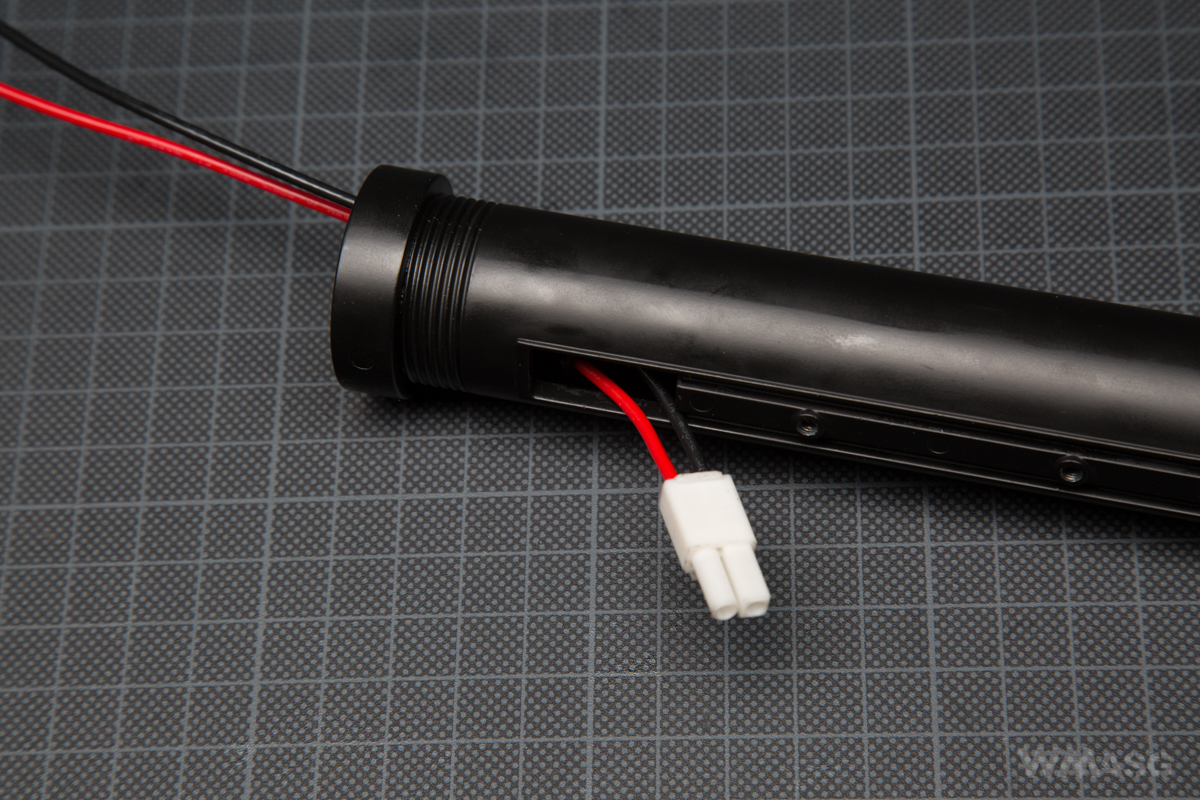 Thanks to the guide, it is possible to set the buttstock in five additional positions. Unfortunately, the adjustment can only be made with a 4 mm Allen key. You have to unscrew the set screw located in the lower part of the stock, set it by finding the right socket at the bottom of the stock guide and tighten the screw. The adjustment on the guide allows to set the length of the buttstock in the range of 27 to 36 cm. Of course, there is the possibility to further lengthen it by extending the back plate. The buttstock also has space for the battery (inside the guide). Access to this compartment is obtained by turning a screw located just above the QD belt mounting point buy a quarter of a turn and sliding the the stock back. A LiPo 11.1 V 1400 mAh battery pack, with dimensions of 21 x 20 x 130 mm, fits there without any problems.
Thanks to the guide, it is possible to set the buttstock in five additional positions. Unfortunately, the adjustment can only be made with a 4 mm Allen key. You have to unscrew the set screw located in the lower part of the stock, set it by finding the right socket at the bottom of the stock guide and tighten the screw. The adjustment on the guide allows to set the length of the buttstock in the range of 27 to 36 cm. Of course, there is the possibility to further lengthen it by extending the back plate. The buttstock also has space for the battery (inside the guide). Access to this compartment is obtained by turning a screw located just above the QD belt mounting point buy a quarter of a turn and sliding the the stock back. A LiPo 11.1 V 1400 mAh battery pack, with dimensions of 21 x 20 x 130 mm, fits there without any problems.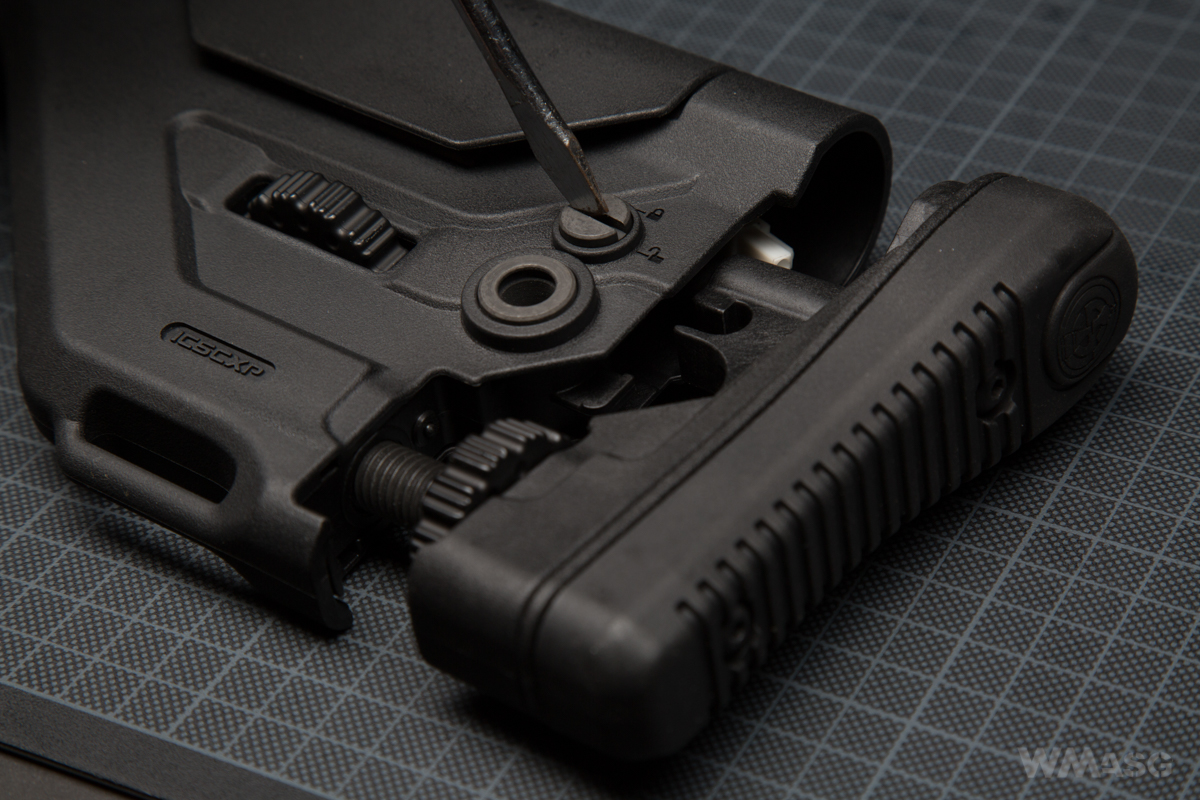
The magazine
A polymer Hi-Cap magazine has a capacity of 300 BBs. It is similar to the PMAG magazines that have a side window. Through the window you can control the amount of ammunition inside. The spring of the magazine is wound with a wheel at the bottom. The filling flap closes with a distinct "click" and will not open by itself. Then its open it moves very lightly. You have to be careful when filling the magazine.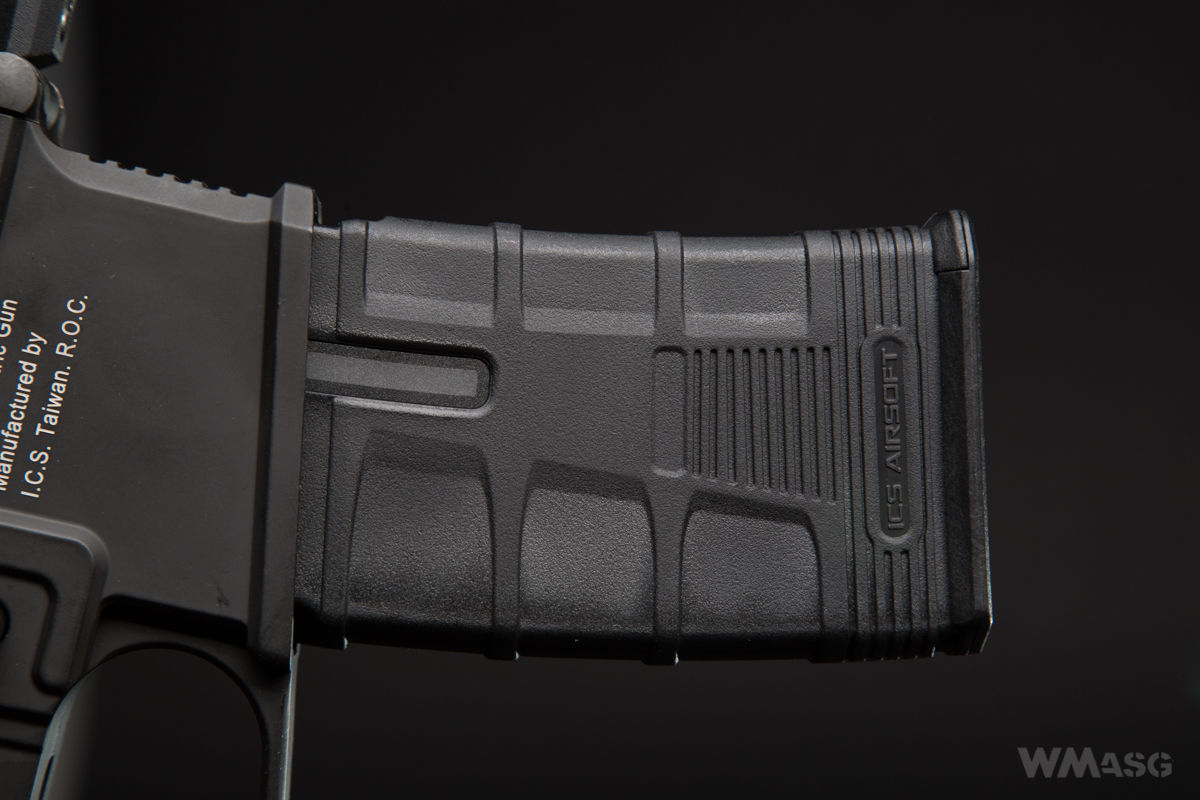
The Blowback
I wrote earlier that MARS replicas are equipped with a mechanical blowback, a system that makes the bolt carrier move forward and back while shooting. The stroke of the bolt carrier is small, equal to approximately half the length of the ejector port.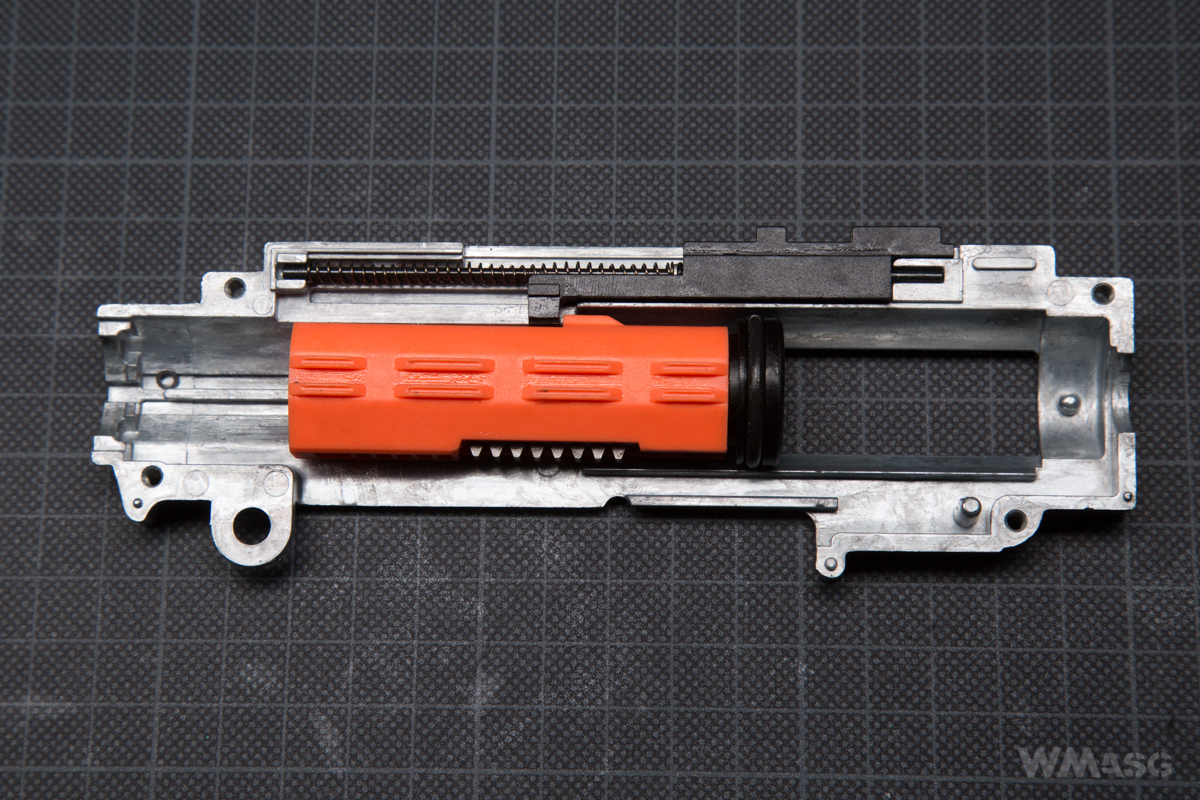
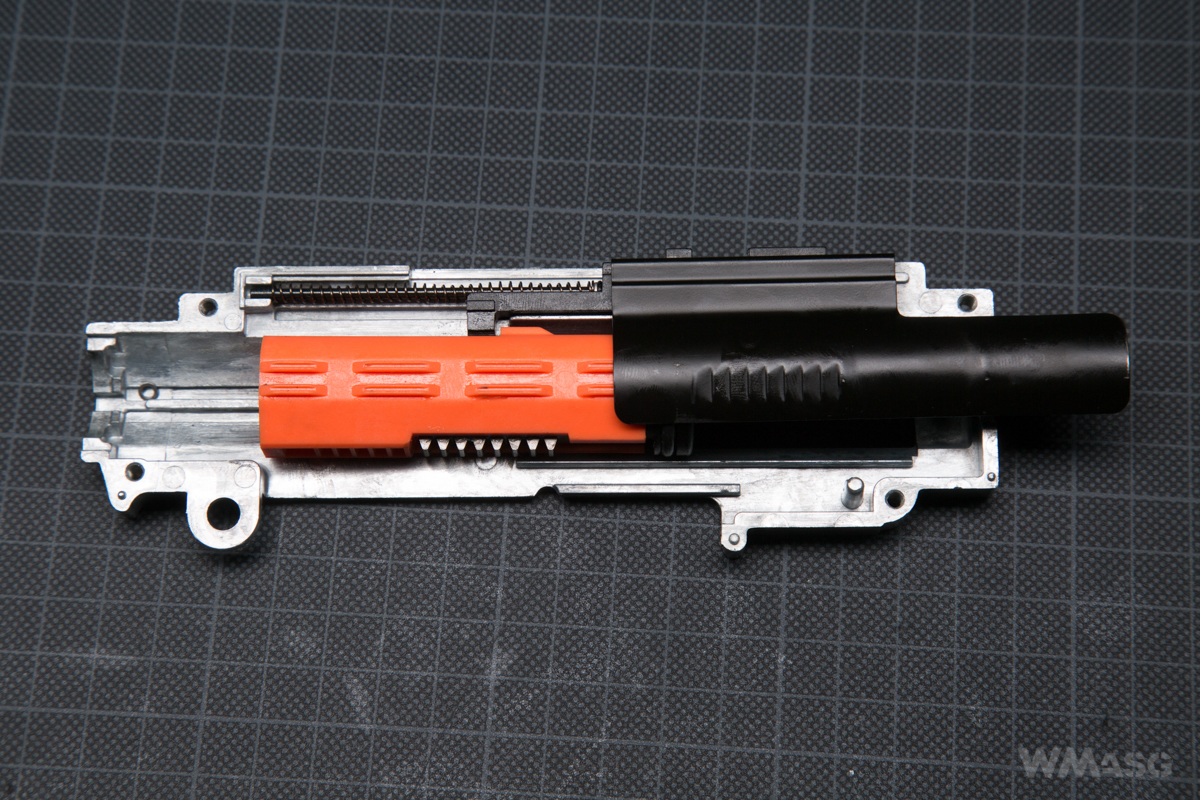 The system is not perfect and does not work in a manner 100% accurate with a real rifle. It happens, for example, that when we release the trigger when shooting in the full-auto mode that the dummy bolt carrier will stop in the middle of the ejector port. It results directly from the EBB design and obstruct anything. For those who will be bothered by this, the solution would be to use an electronic control system that will force the piston to stop in the front position. This way the bolt carrier will always remain closed after firing.
The system is not perfect and does not work in a manner 100% accurate with a real rifle. It happens, for example, that when we release the trigger when shooting in the full-auto mode that the dummy bolt carrier will stop in the middle of the ejector port. It results directly from the EBB design and obstruct anything. For those who will be bothered by this, the solution would be to use an electronic control system that will force the piston to stop in the front position. This way the bolt carrier will always remain closed after firing.
Disassembly and assembly
MARS, like all ARs by ICS, belong to break open type replicas. To disassembly them down, one has to take out the rear pin and "break" the replica open. Then you can take out the front pin and disconnect the upper and the lower receiver. The pins are protected against falling out.
Just like in the replicas described elsewhere, in the MMR series, the heart of the replica is the well-known two-part gearbox, which also has the feature of quickly spring change system. After breaking open the carbine, you can replace the spring by lightly pressing and turning the spring guide by 45 degrees. The entire upper part of the gearbox can be easily taken out by pulling it with the charging handle. In the solution used, the lever is connected to it. There is no spring connecting the lever with the upper receiver.
In order to pull out the lower half of the gearbox you have to unscrew the pistol grip, the magazine latch and unscrew and take off the buttstock guide.
When assembling or just closing the opened replica, it is extremely important to correctly align the gears. This method is clearly described in the instructions manual and it is essential to follow these instructions. Inappropriate piston position relative to the gears leads to an immediate damage to the replica.
Internal parts of the upper half of the gearbox
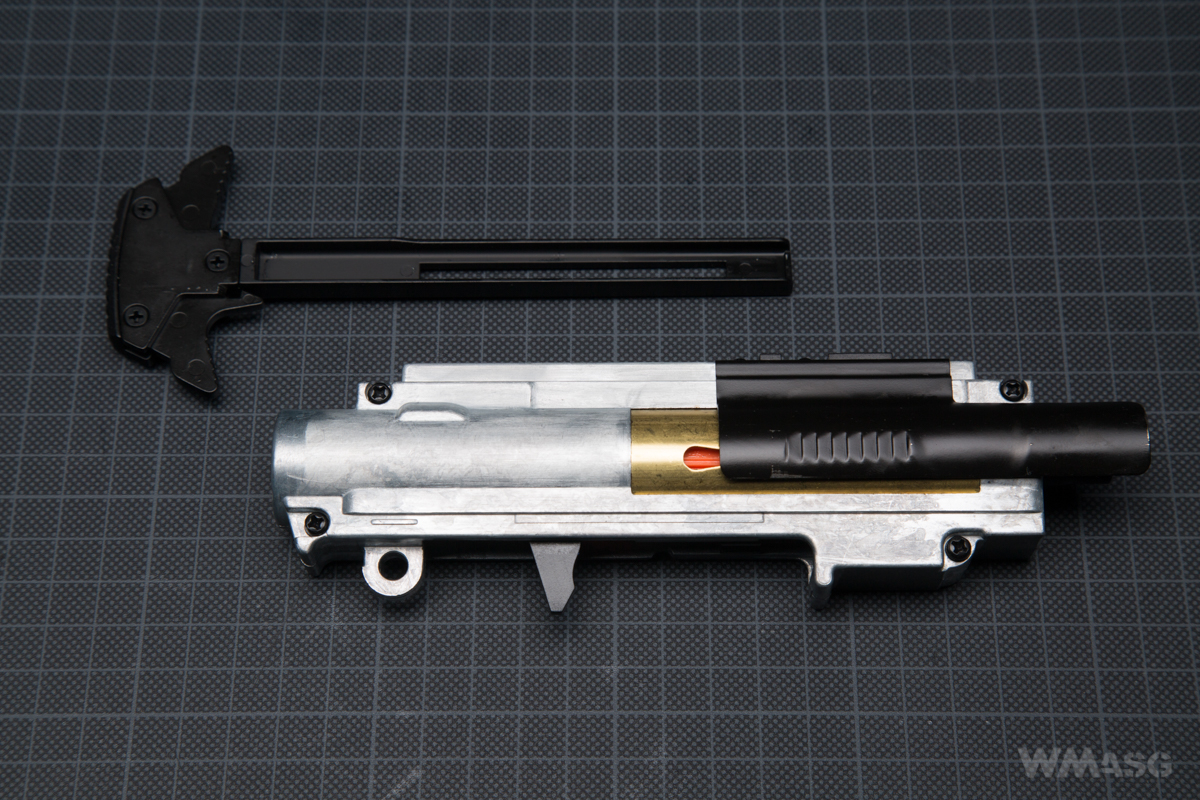 For comparison: at the top the MARS gearbox with the blowback system, at the bottom an "ordinary" ICS gearbox.
For comparison: at the top the MARS gearbox with the blowback system, at the bottom an "ordinary" ICS gearbox.
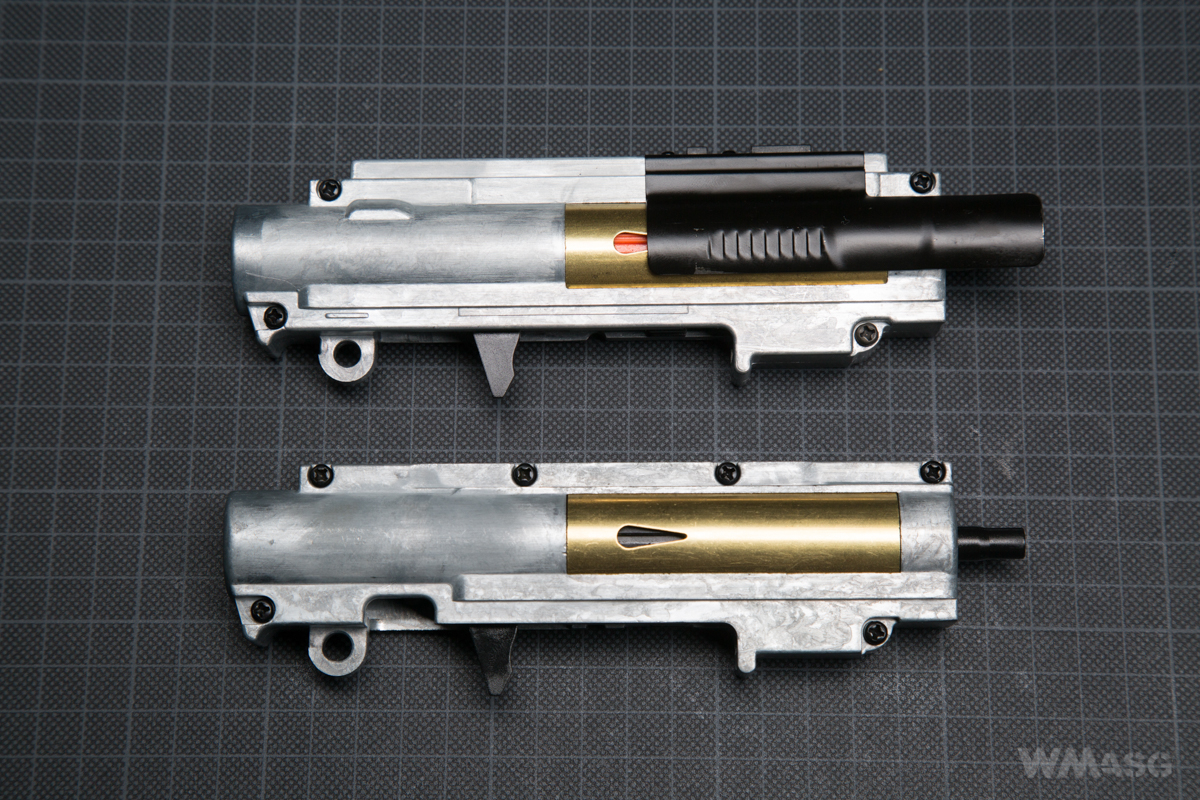
Once again, but with the dummy bolt carrier dismantled.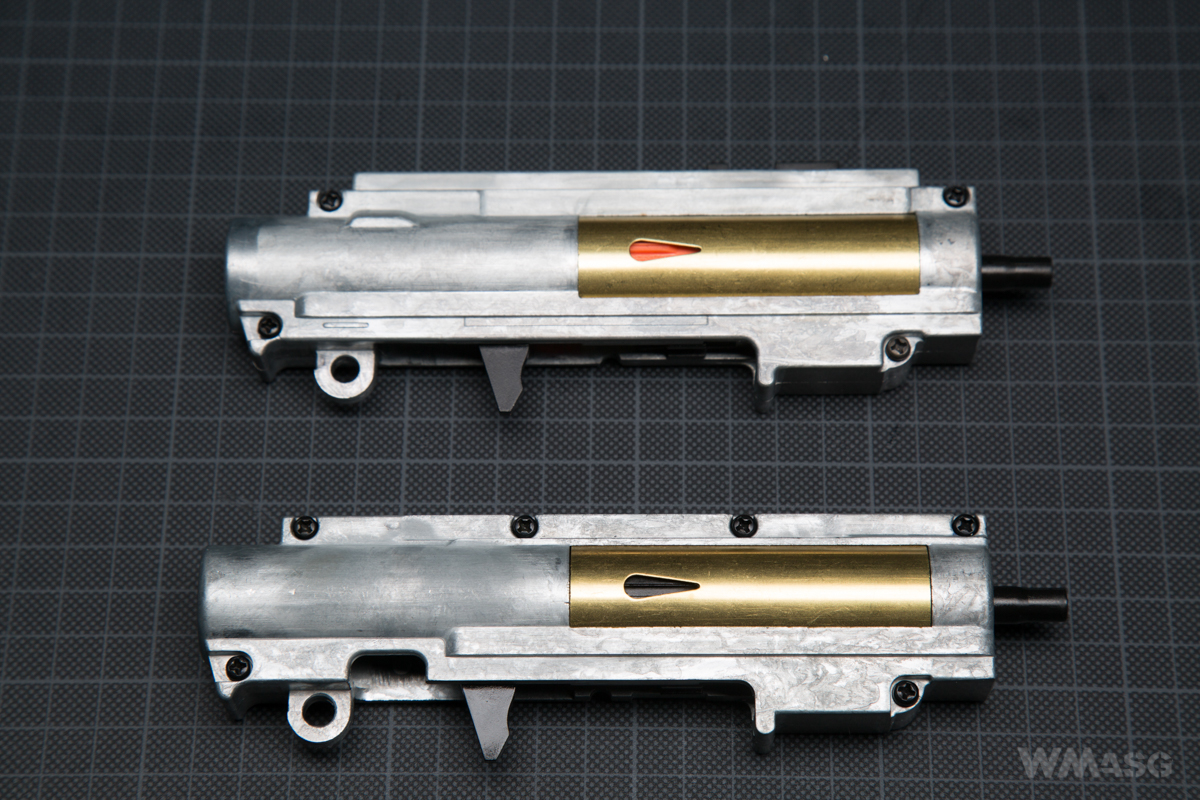
In addition to the piston and spring guide, the inner parts are made according to the unwritten standard.
The piston has eight steel teeth and a characteristic hook on its top used to drive the blowback system.
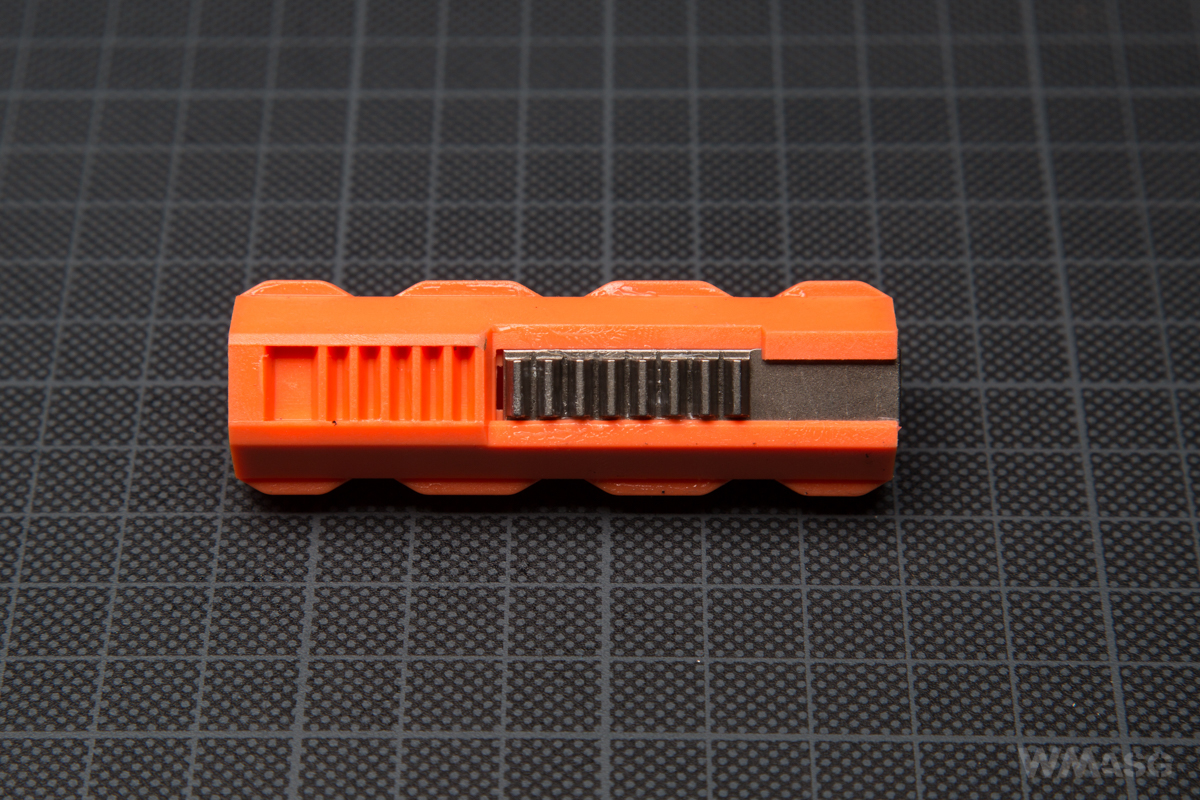
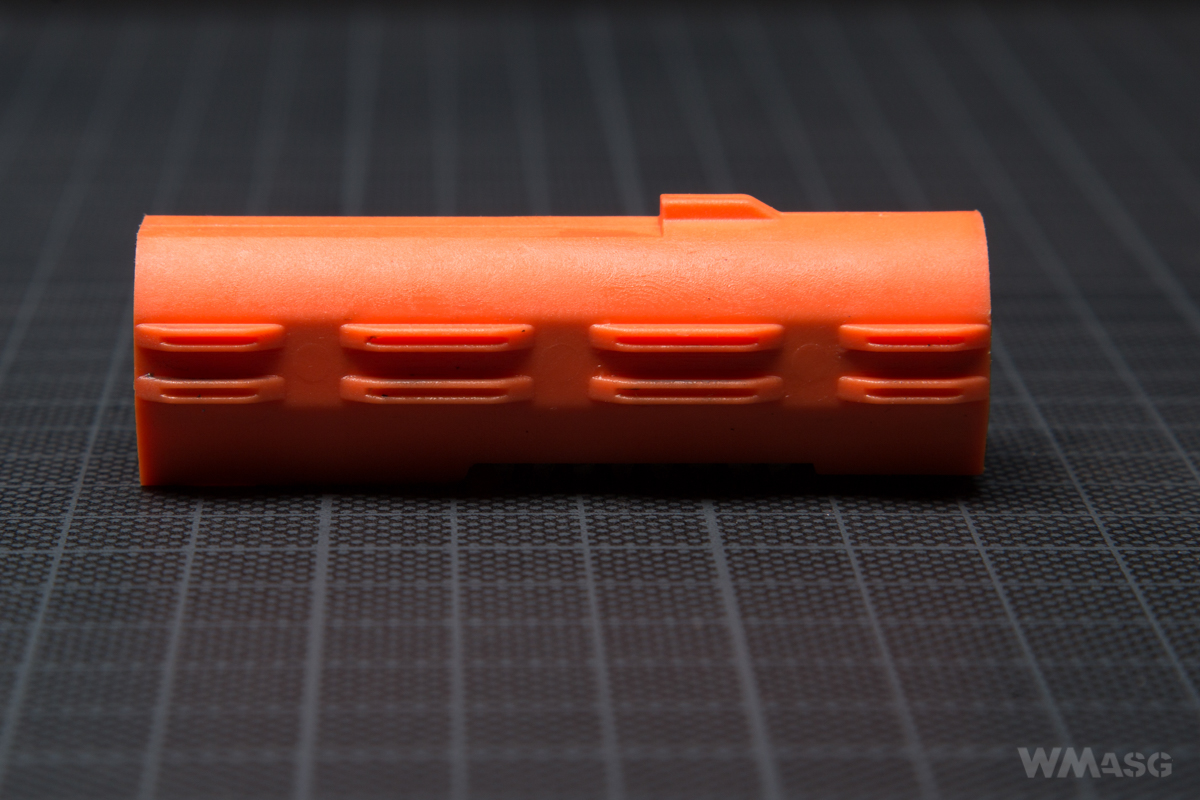
The spring guide with four tabs (for quick spring replacement).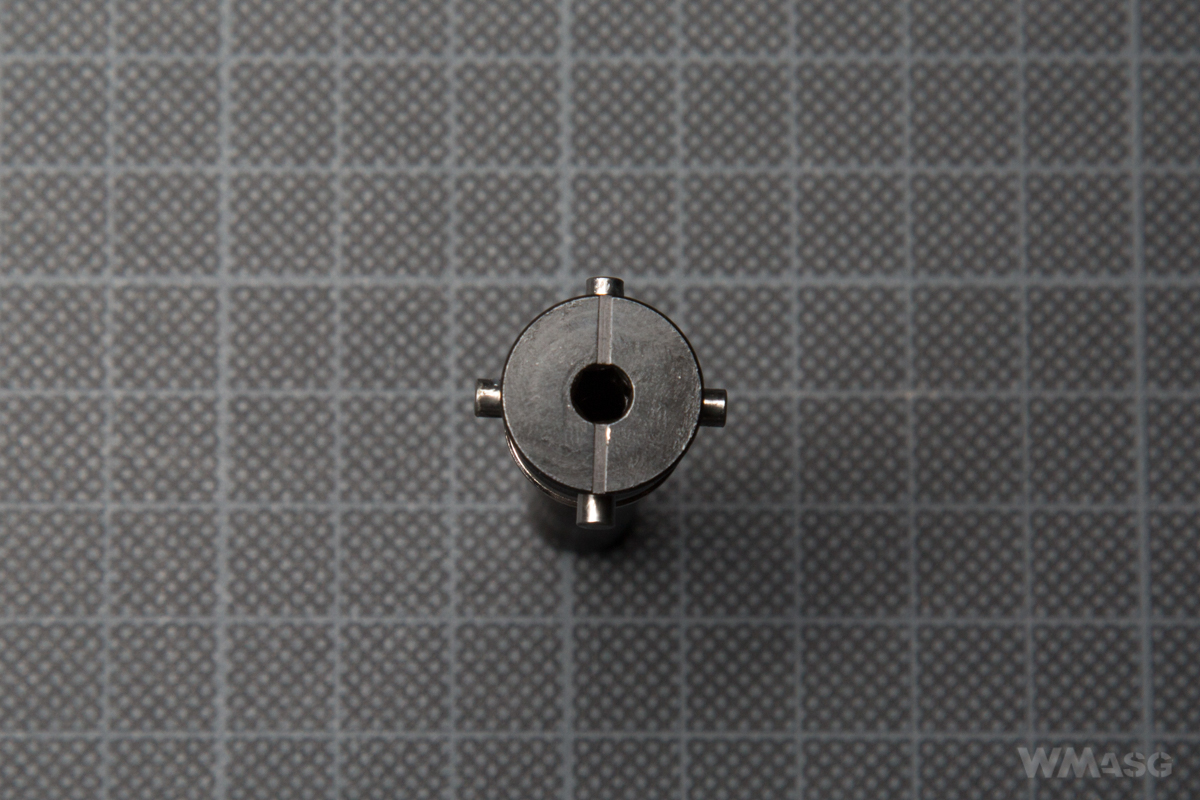
Below is a comparison of gearboxes with and without the possibility of quickly replacing the spring.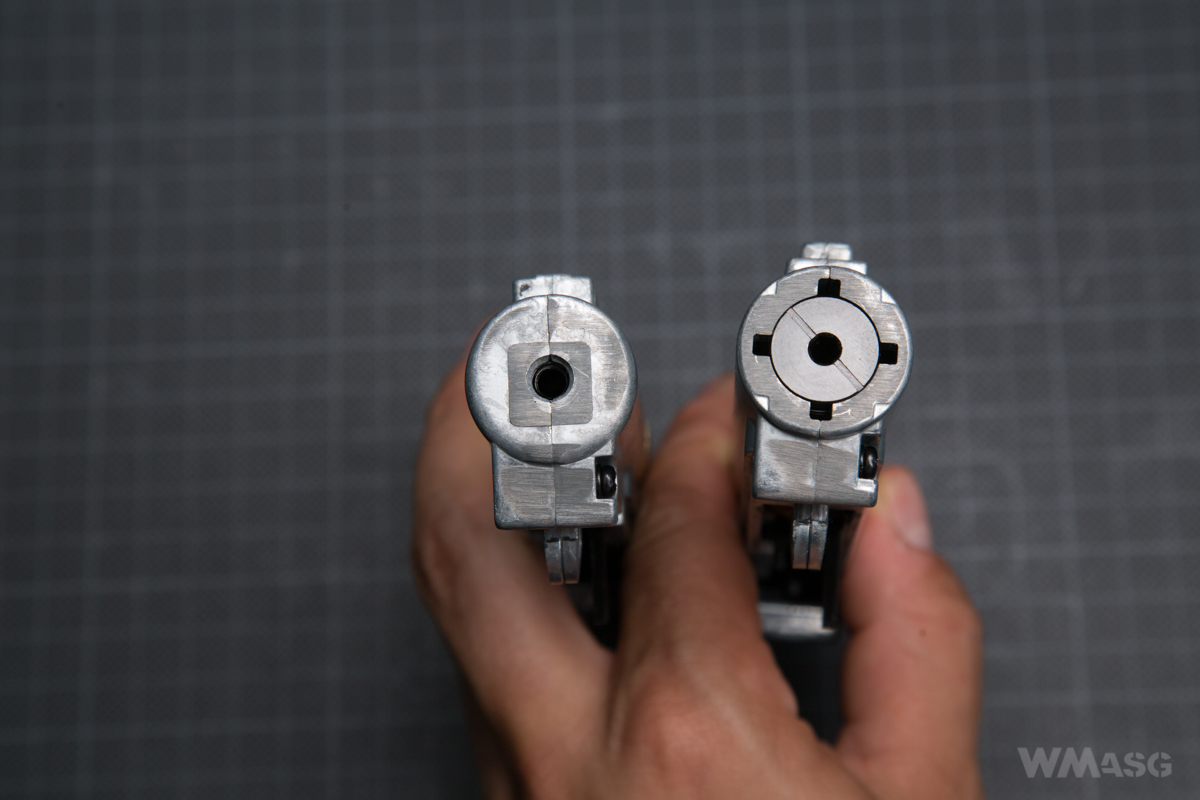
Other parts - a type 2 cylinder.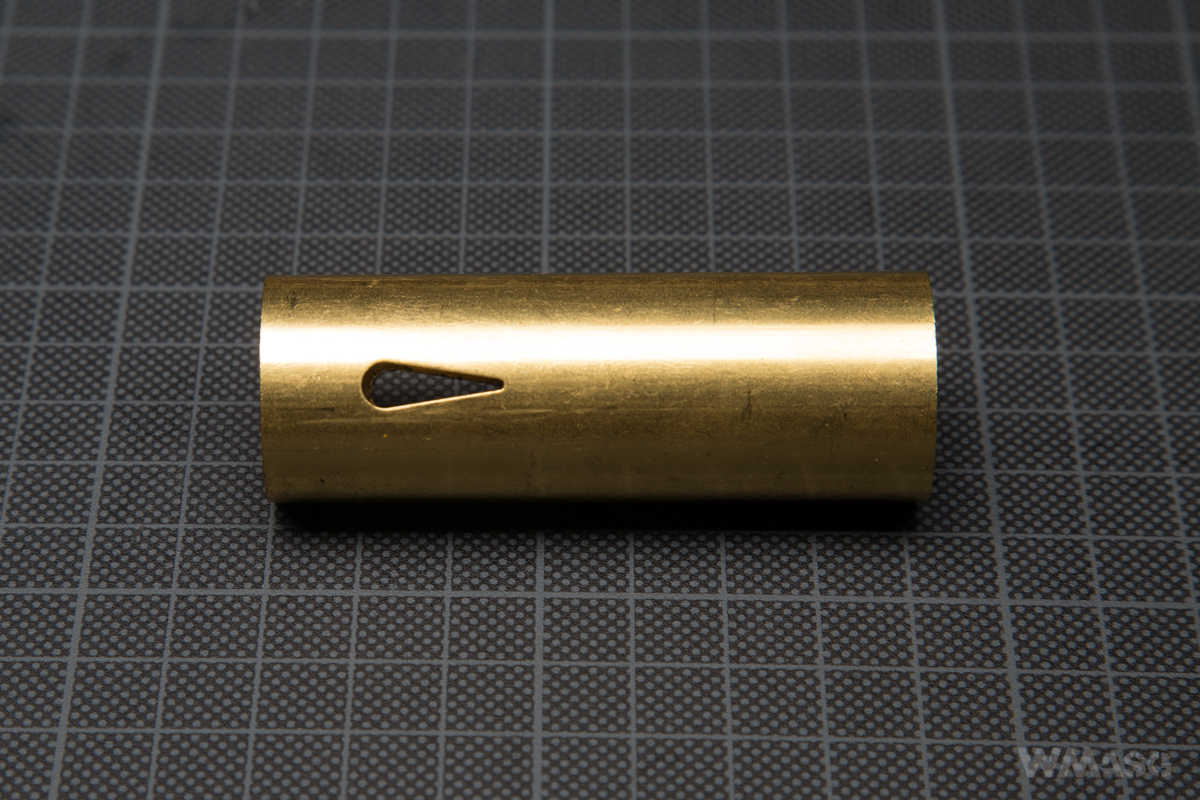 A polymer type 2 cylinder head with 1 sealing o-ring.
A polymer type 2 cylinder head with 1 sealing o-ring.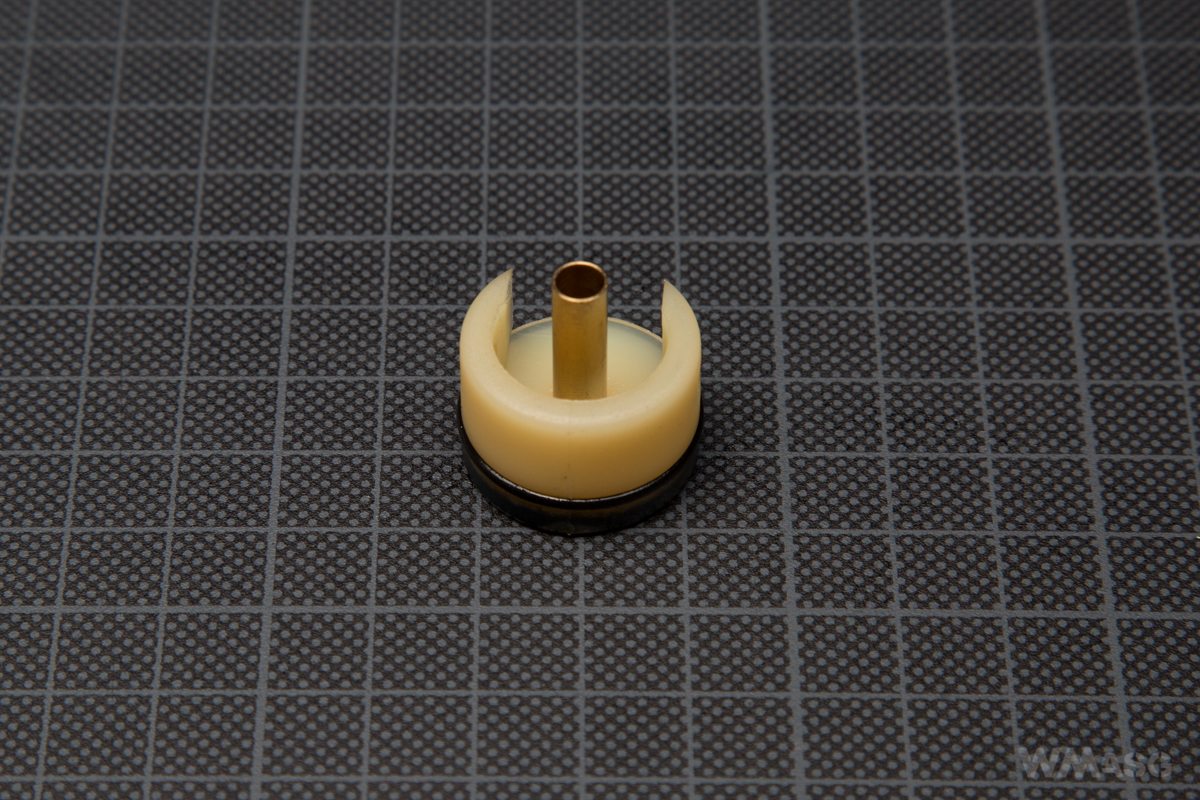 The nozzle is 20.94 mm long and has no o-ring.
The nozzle is 20.94 mm long and has no o-ring.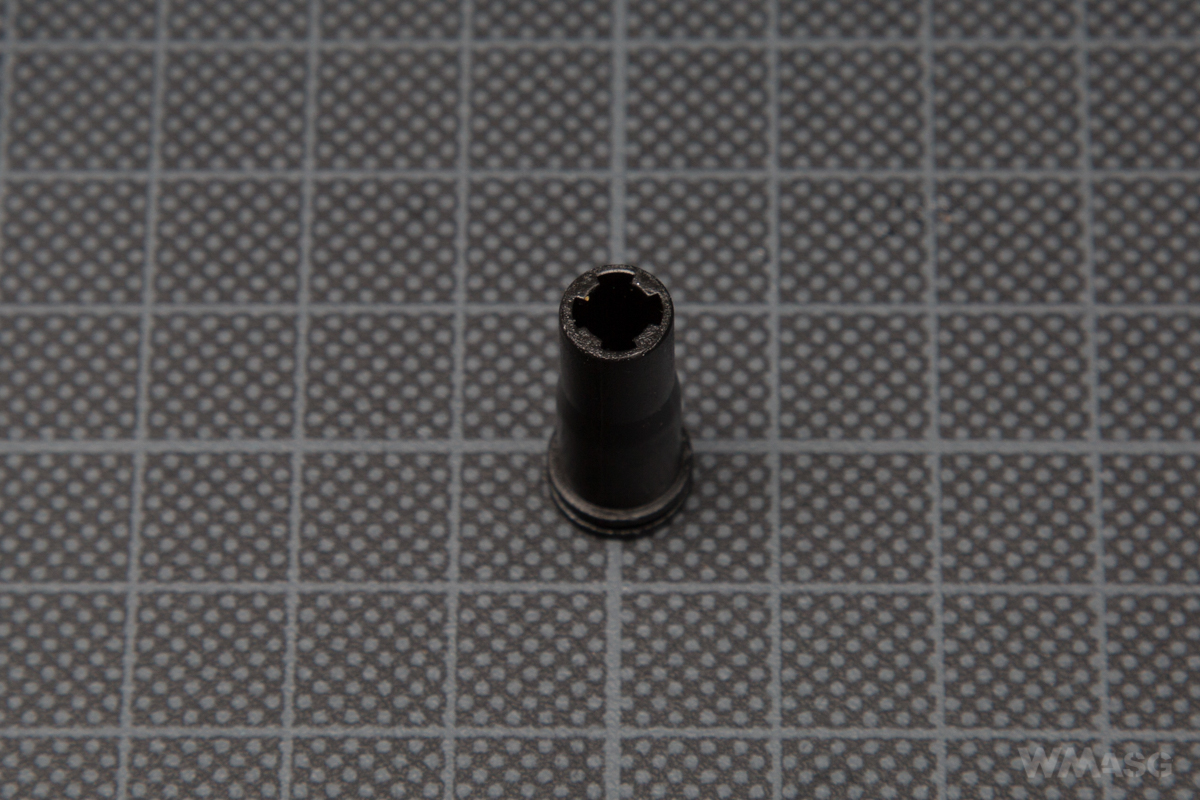
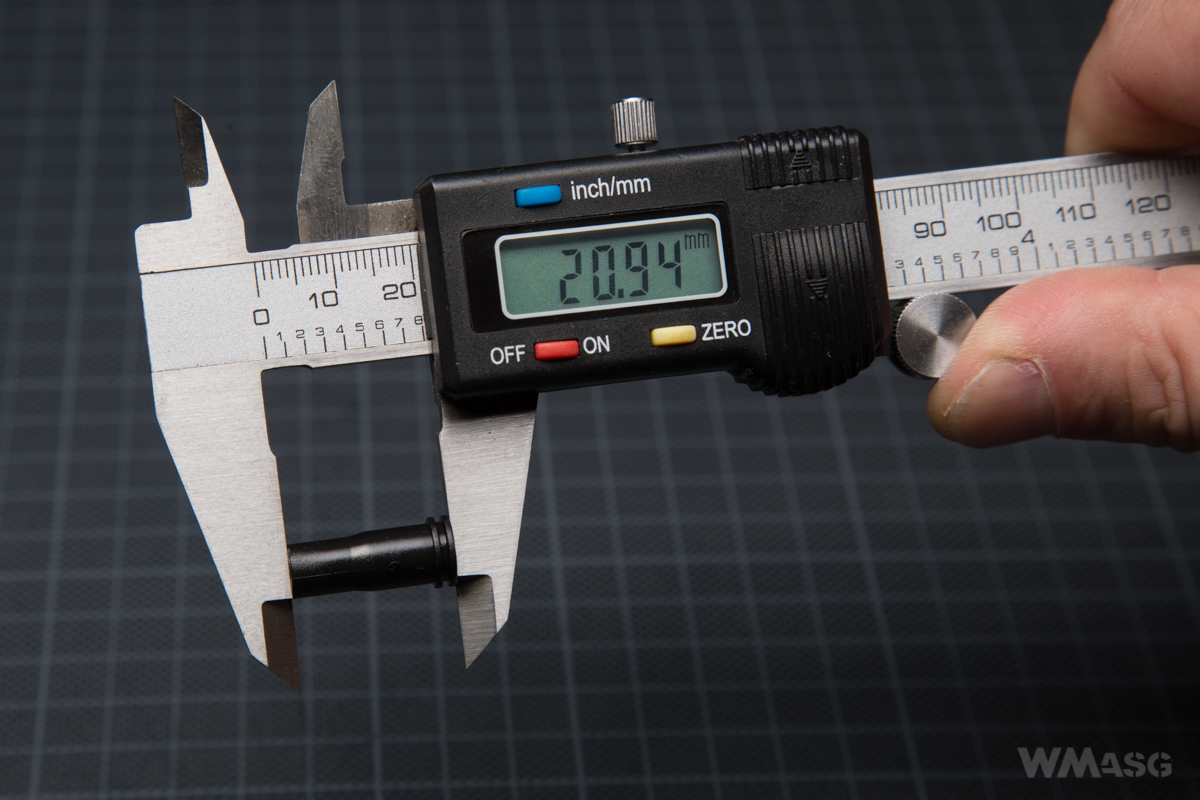 A polymer piston head has a full bearing.
A polymer piston head has a full bearing.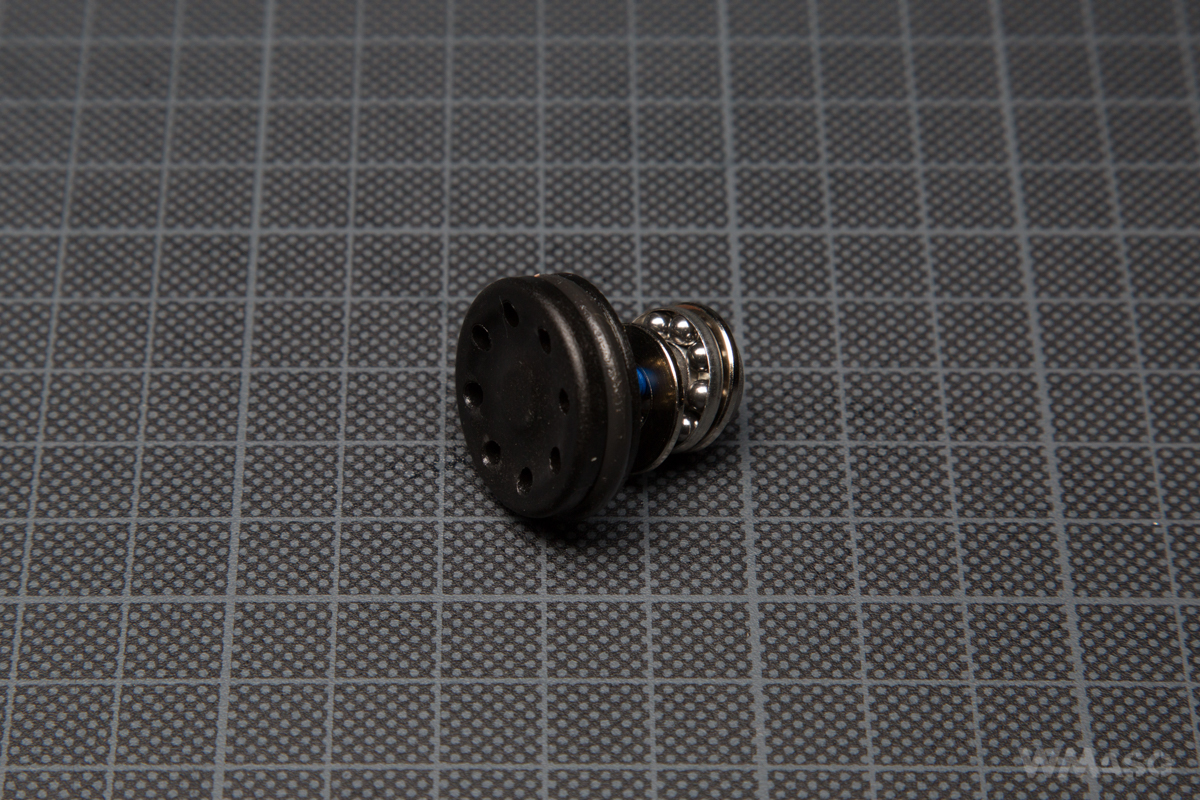 A spring with regular coils.
A spring with regular coils.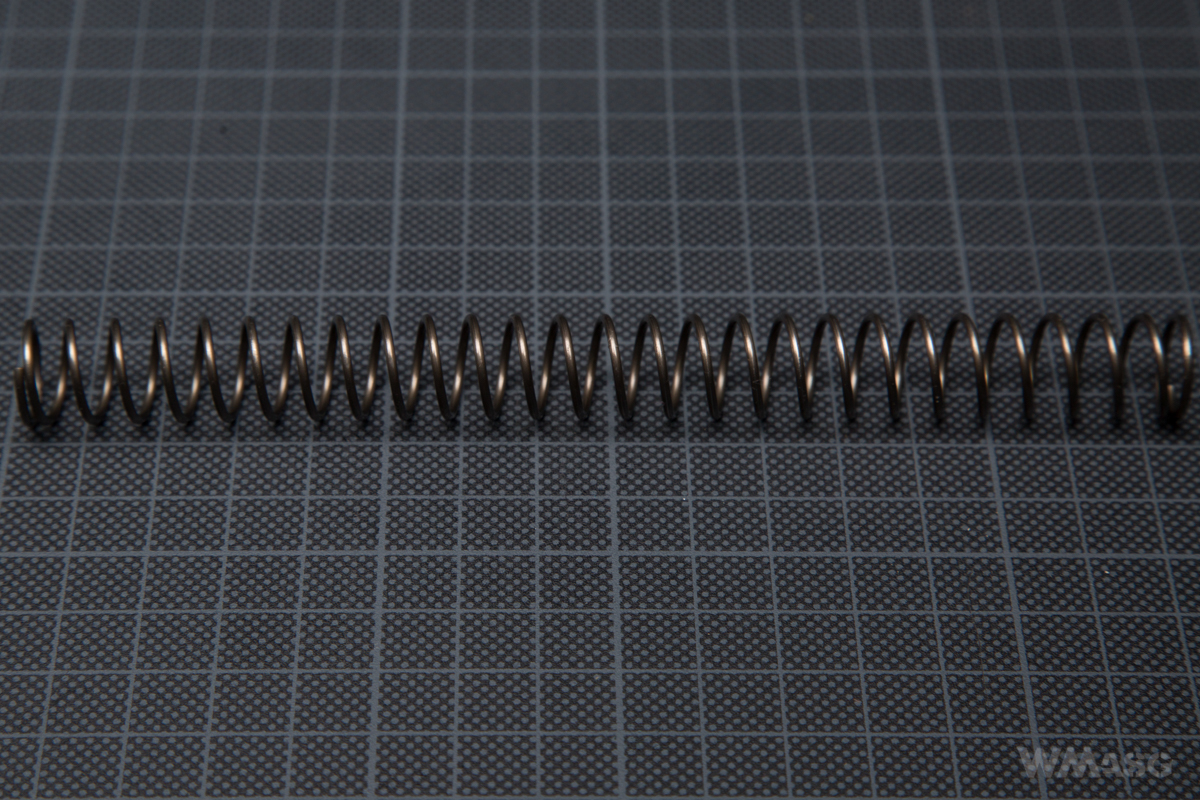 A standard taped plate used in V2 gearboxes.
A standard taped plate used in V2 gearboxes.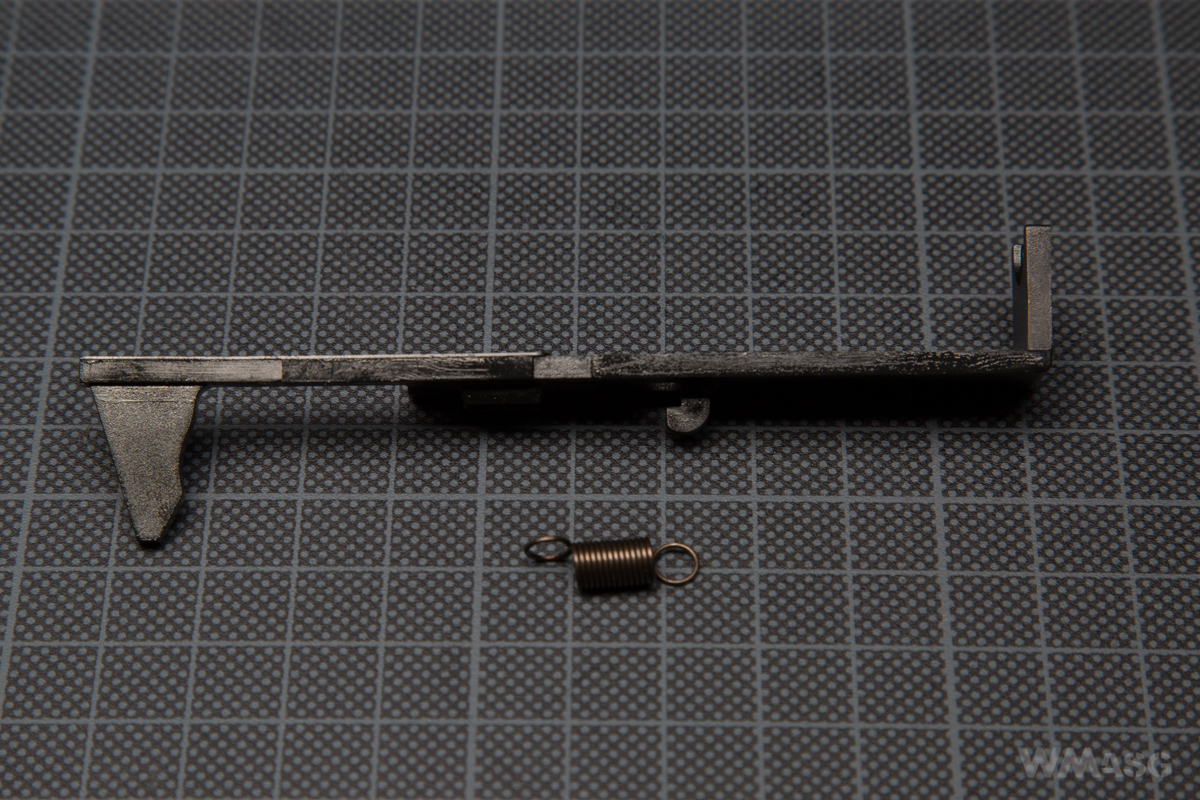
Internal parts of the lower half of the gearbox
The gears inside the gearbox have slight lateral play.
Steel 7 mm bushings. The gears are standard, made of steel and sintered.
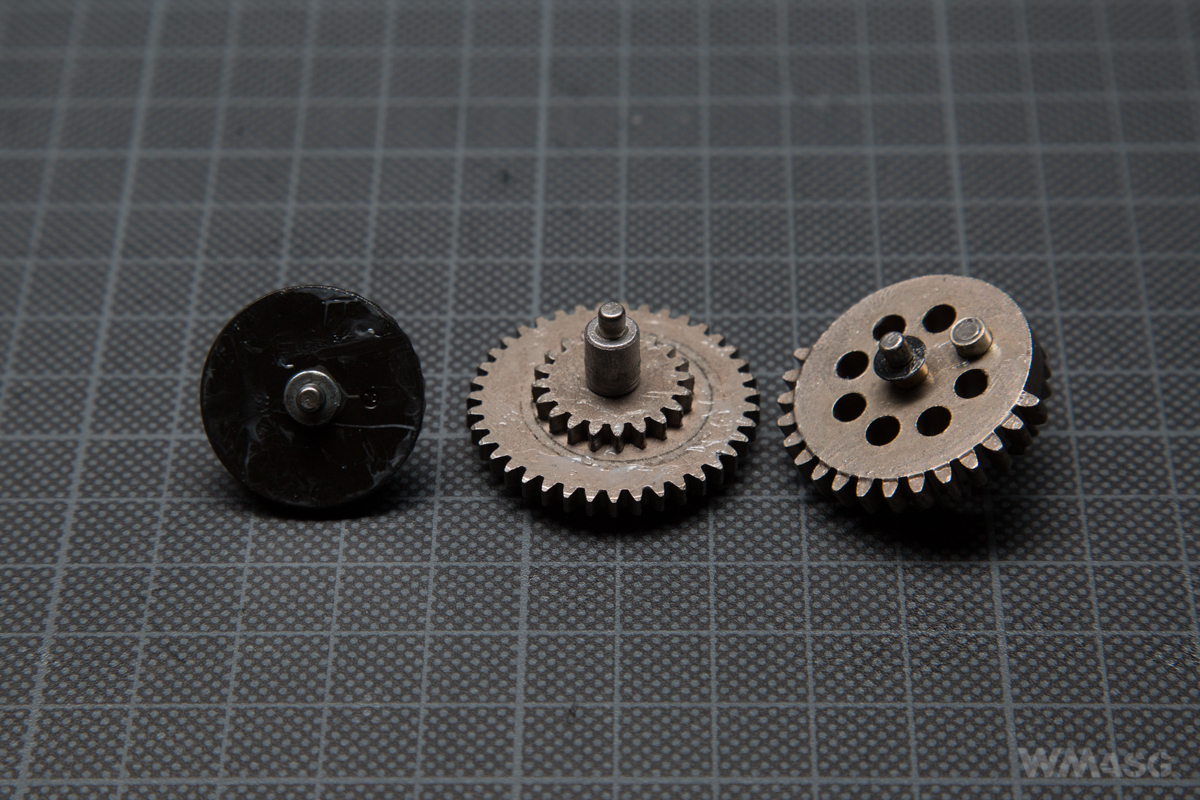 The bevel gear and one on the motor shaft made in MIM (Metal Injection Molding) technology. Both do look completely different than the others.
The bevel gear and one on the motor shaft made in MIM (Metal Injection Molding) technology. Both do look completely different than the others.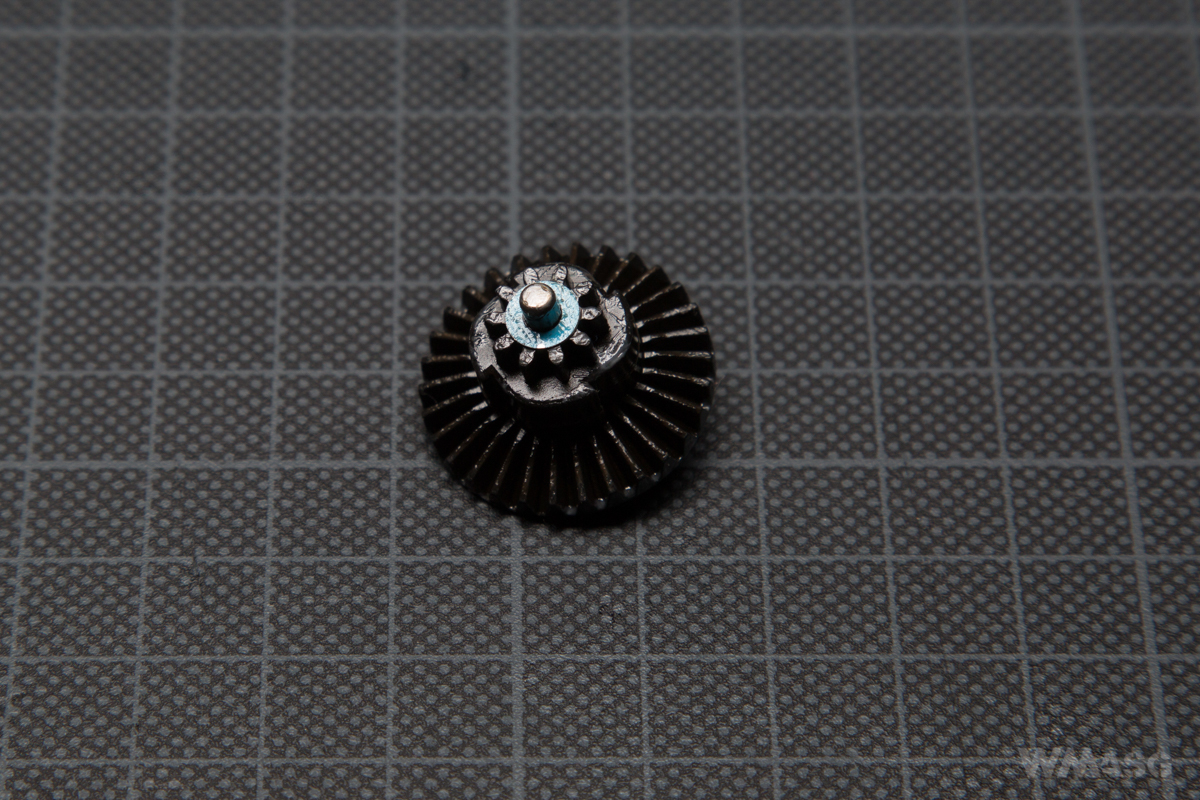 On the sector gear a thin sleeve is applied to the tappet plate driving rod, which is likely to improve the feeding of the BBs.
On the sector gear a thin sleeve is applied to the tappet plate driving rod, which is likely to improve the feeding of the BBs.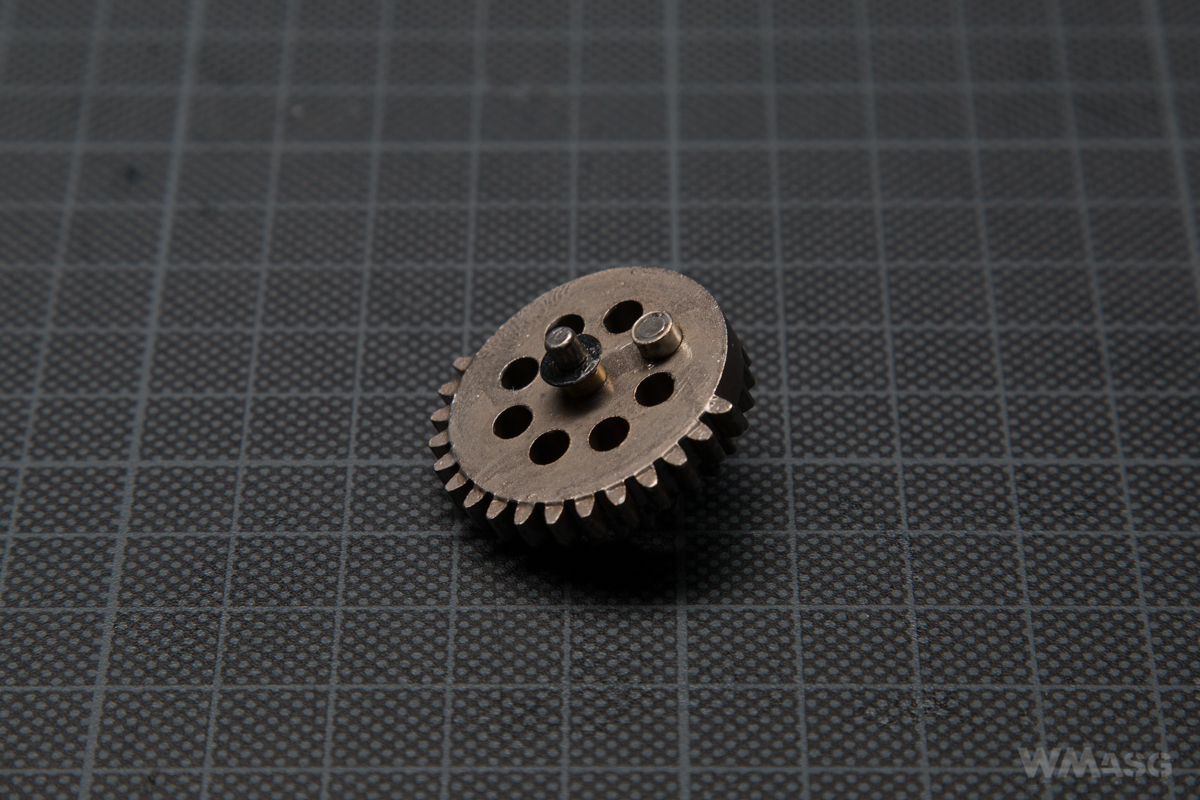
The cut-off lever switch and the trigger lock are both standard V2 gearbox parts.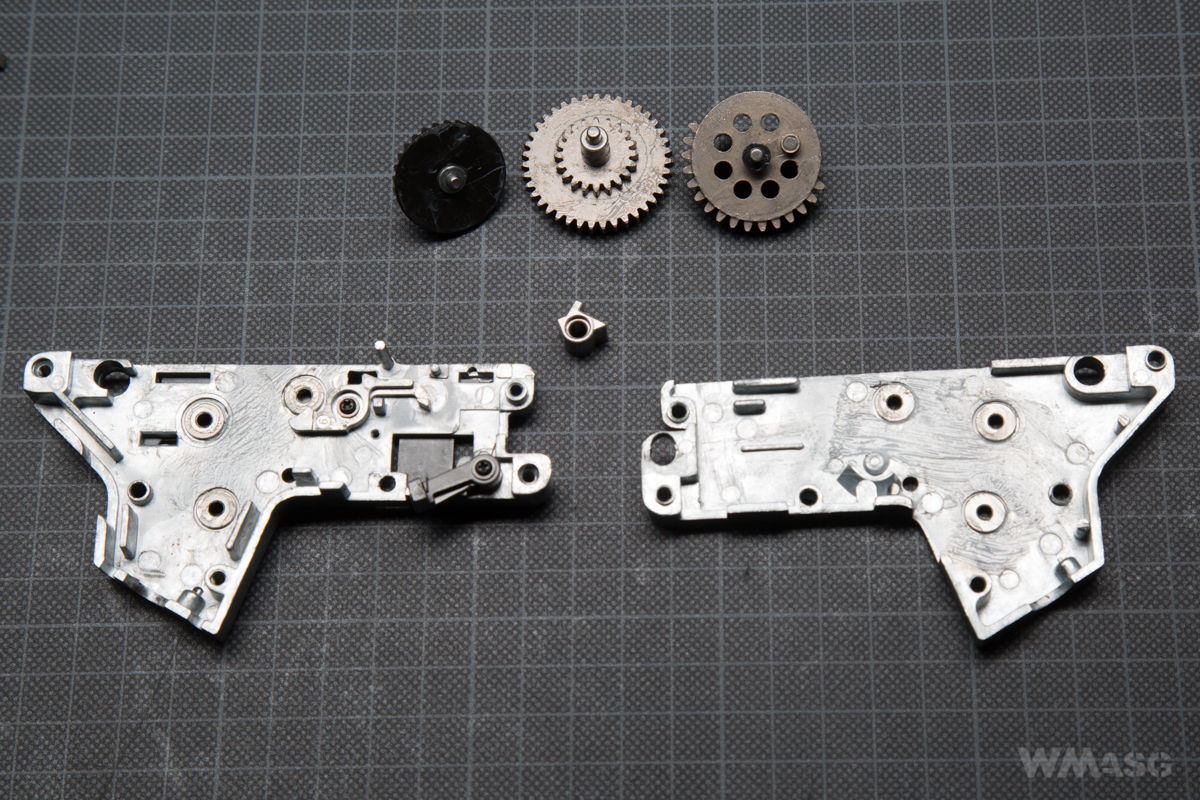
The trigger is vertical, straight, like in sporting rifles.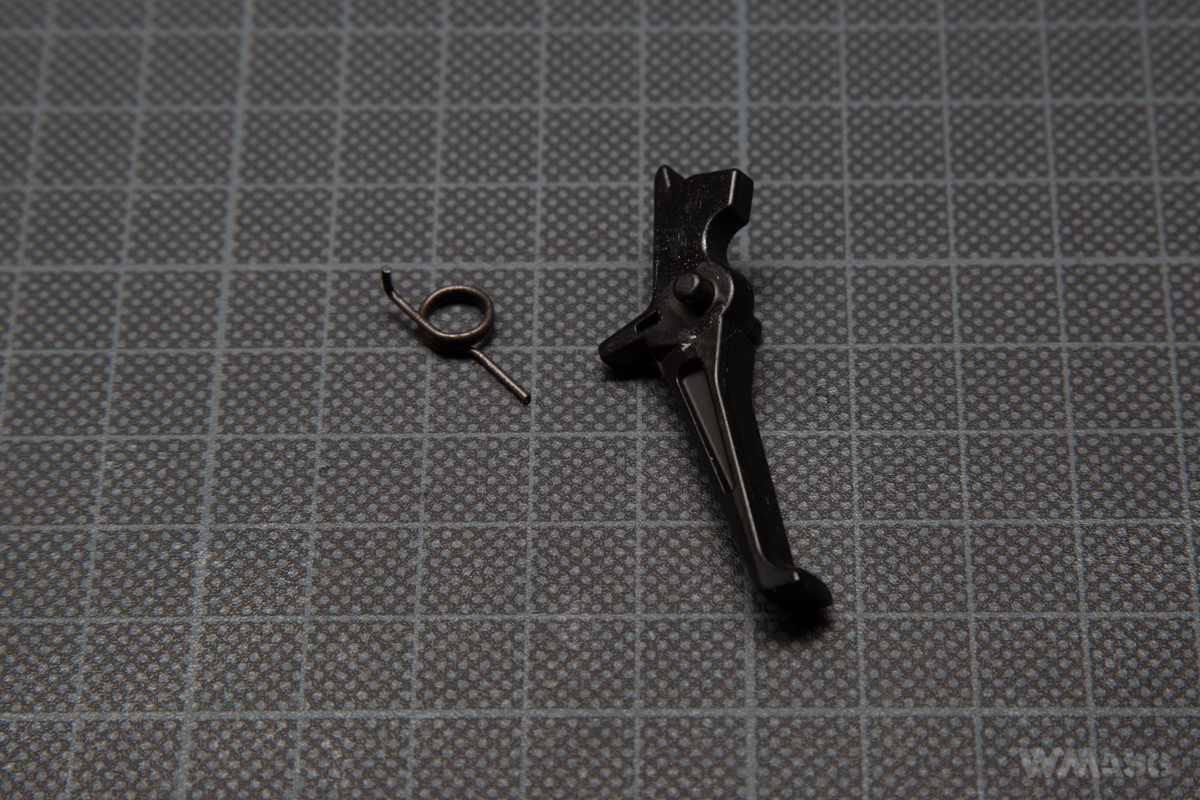
The trigger switch is f the standard V2 gearbox type without additional external contacts closed by the selector plate.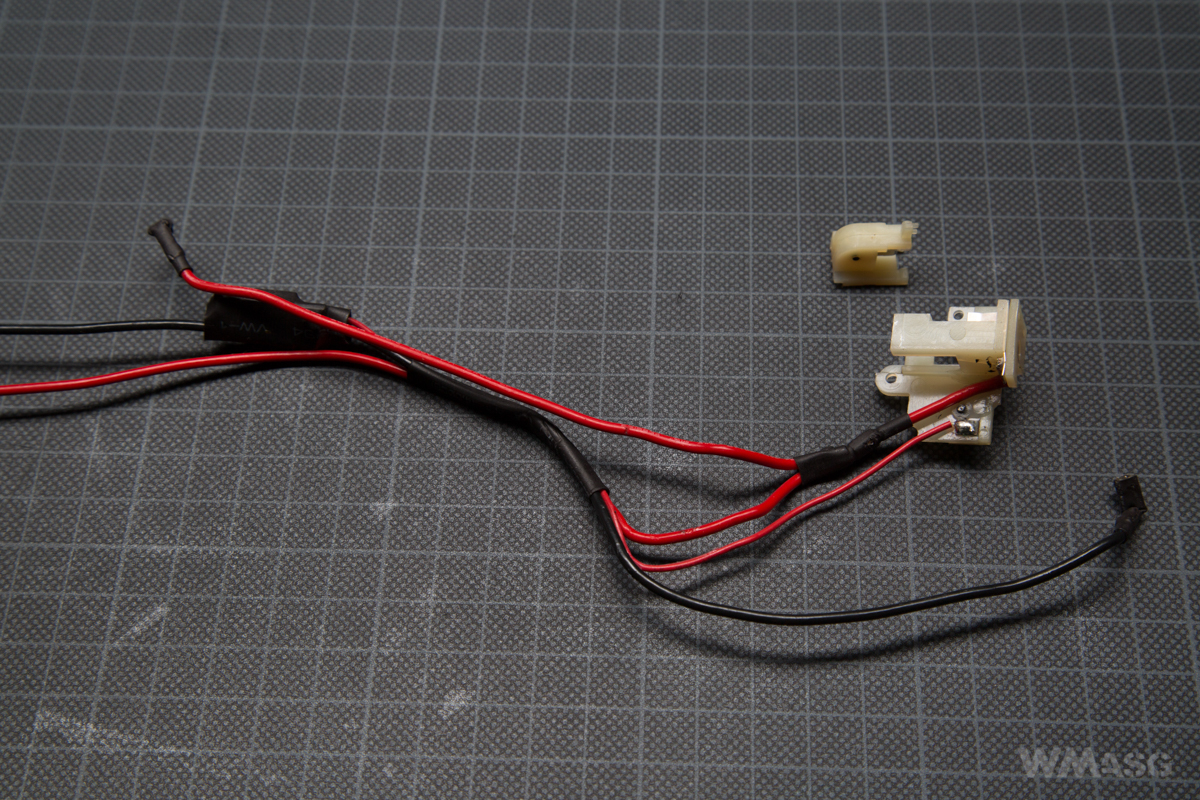
The wire are rigid, encased in hard insulation. The wiring is equipped with a simple MOSFET circuit. The installation method simplified, no separate control wires are used. There is also a mini type fuse. The battery plug is the mini Tamiya type.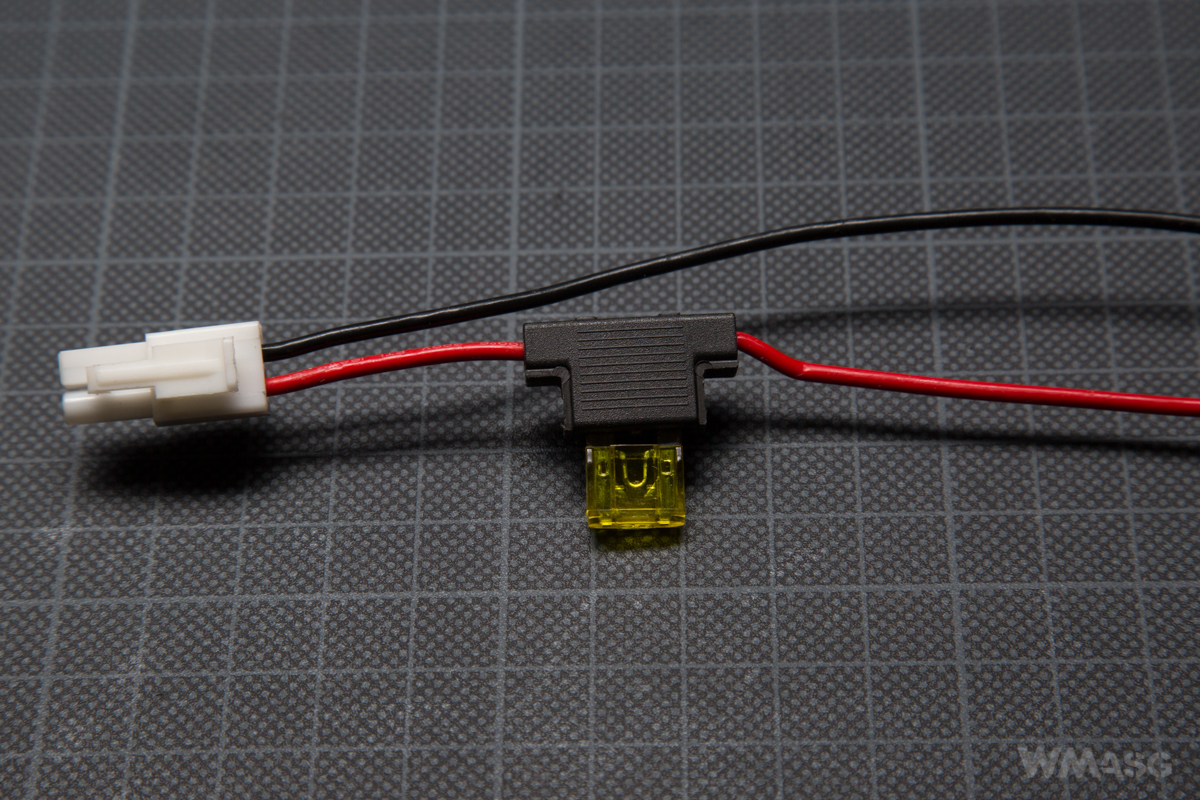
The Anti-reversal latch is different than in other ICS replicas that have the spring release function.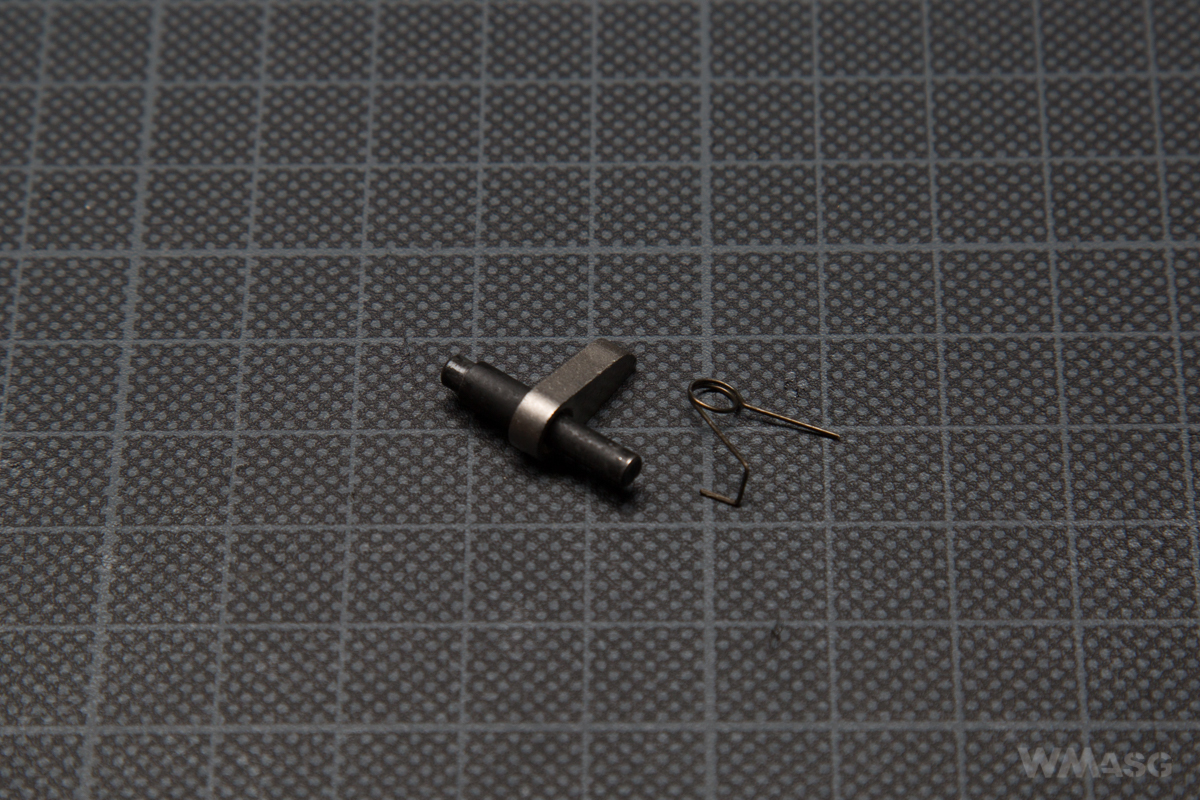 The shape of the working part is standard, but the axle is slightly longer and ends with a characteristic splinted shaft. Part from the MARS is on the right. On the left is the one that works with the forward assist to release the spring.
The shape of the working part is standard, but the axle is slightly longer and ends with a characteristic splinted shaft. Part from the MARS is on the right. On the left is the one that works with the forward assist to release the spring.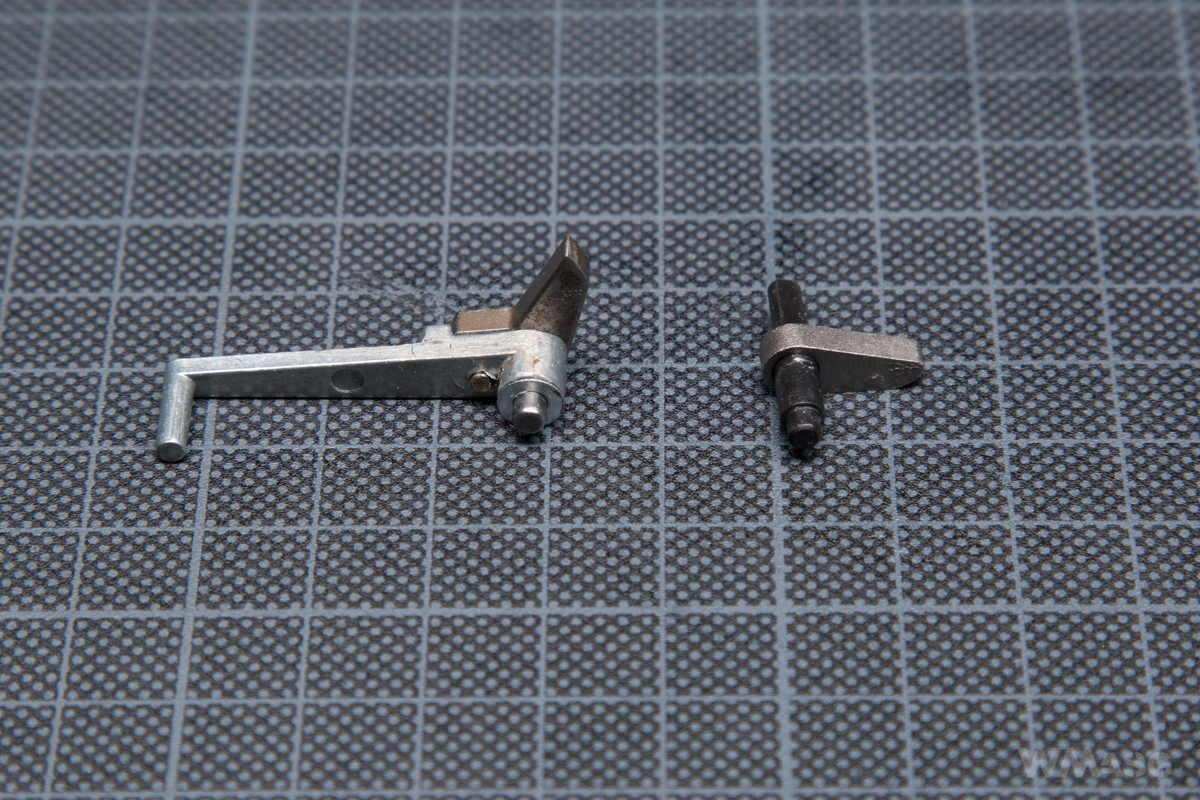
On the outside there is a custom selector plate which is made of metal. In the photos we are showing the difference between the CXP-MARS carbine plate and the standard V2 gearbox version. The MARS is at the top.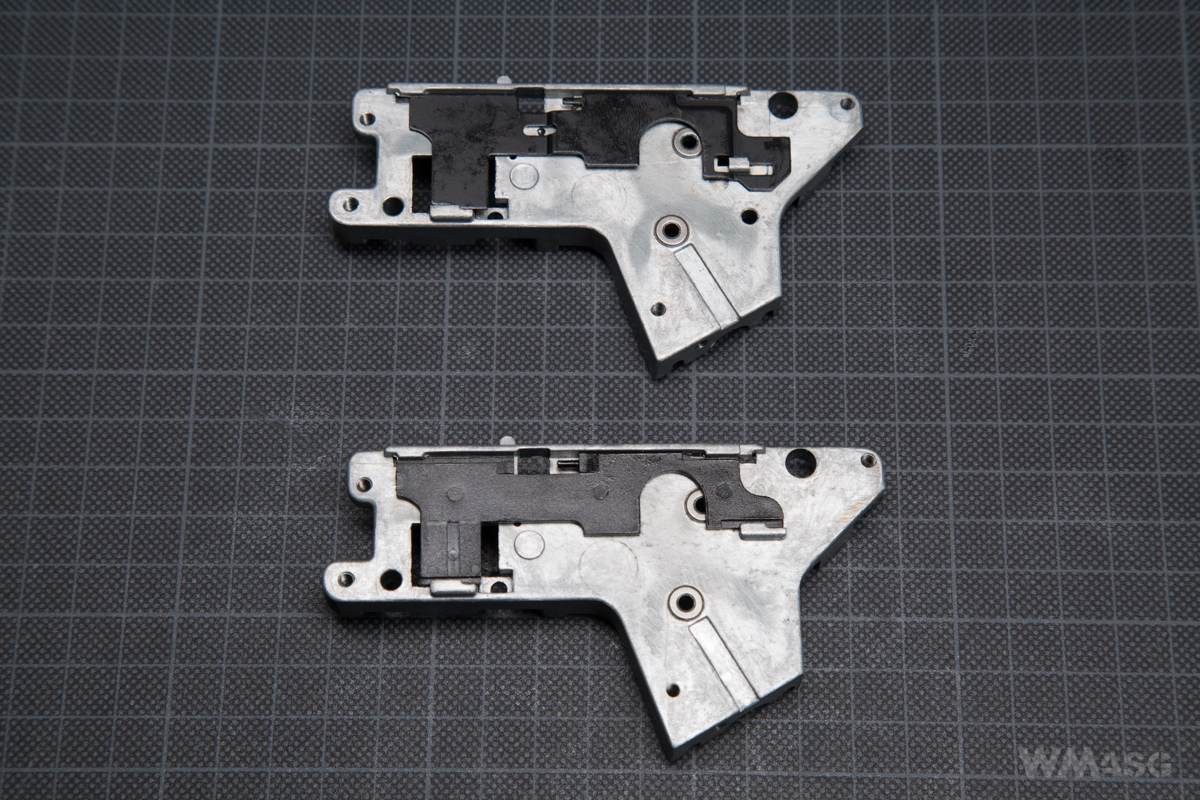
And on the left.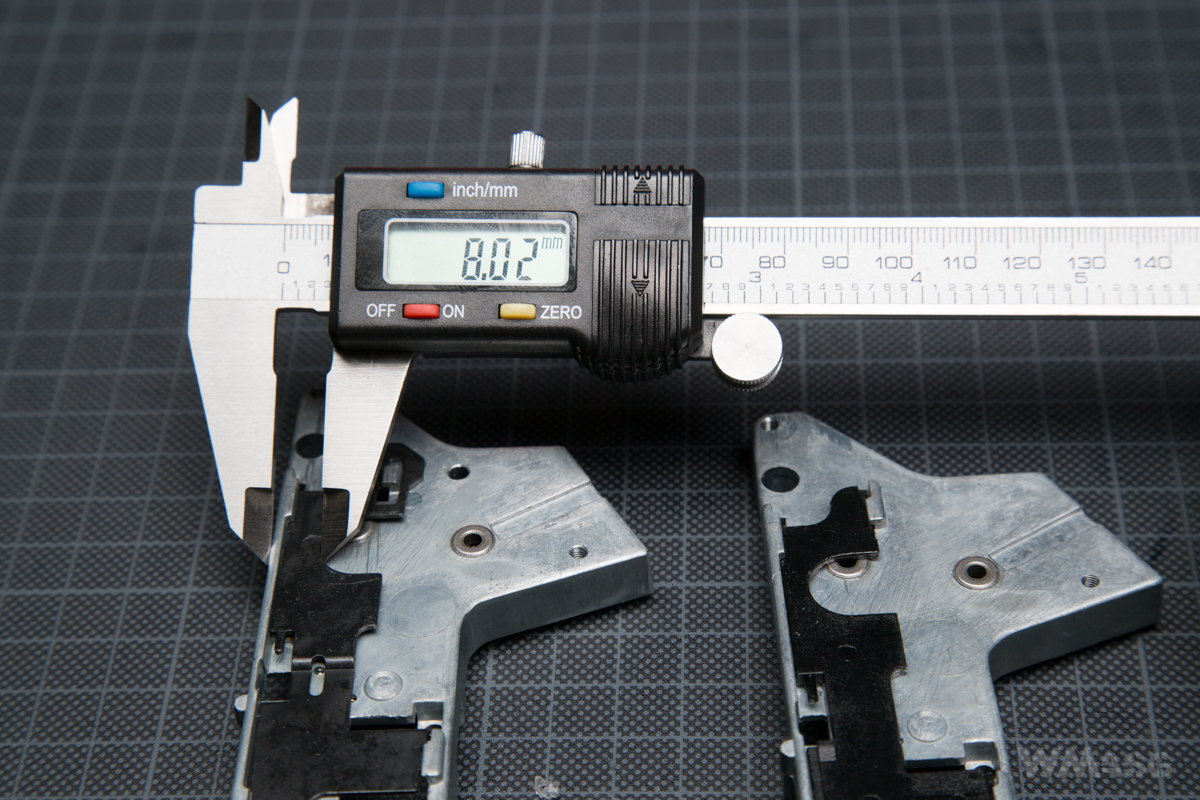
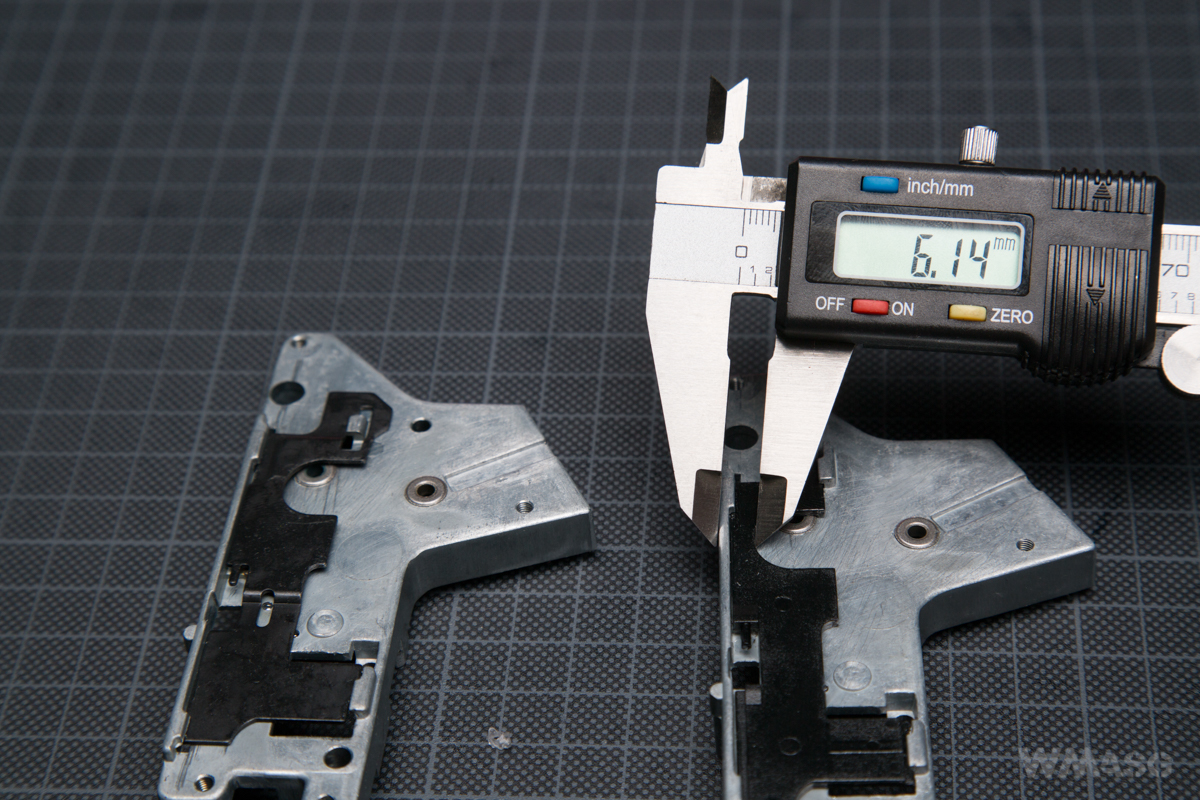
I have not found a word about it, but the MARS series selector plate and anti-reversal latch are the same as those used in the MMR series. While, according to ICS, it does not serve any purpose in the MMR series, in the MARS it is responsible for releasing the spring. But, as you already know, in the tested unit it does not work either.
The long type motor has no markings. The magnets are weak (average), not neodymium.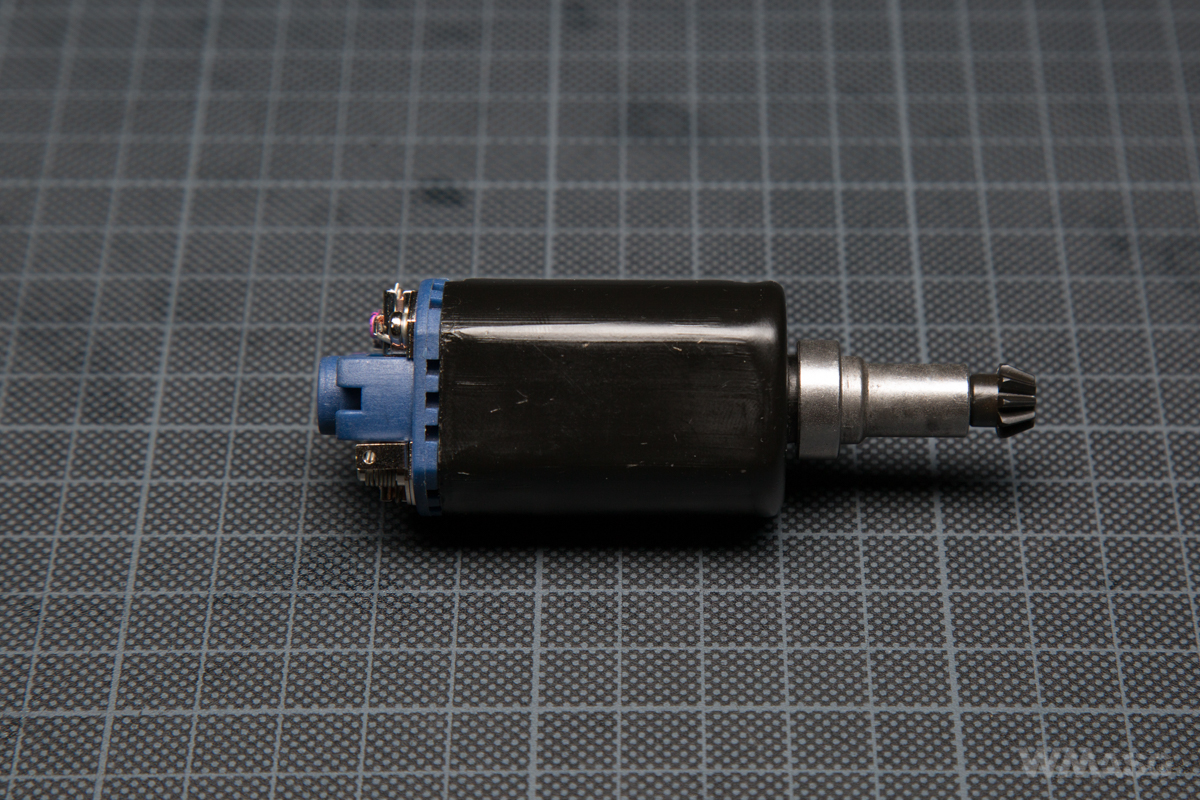
The wires in the pistol grip run straight ahead. The red wire at the front, the black wire at the back of the grip.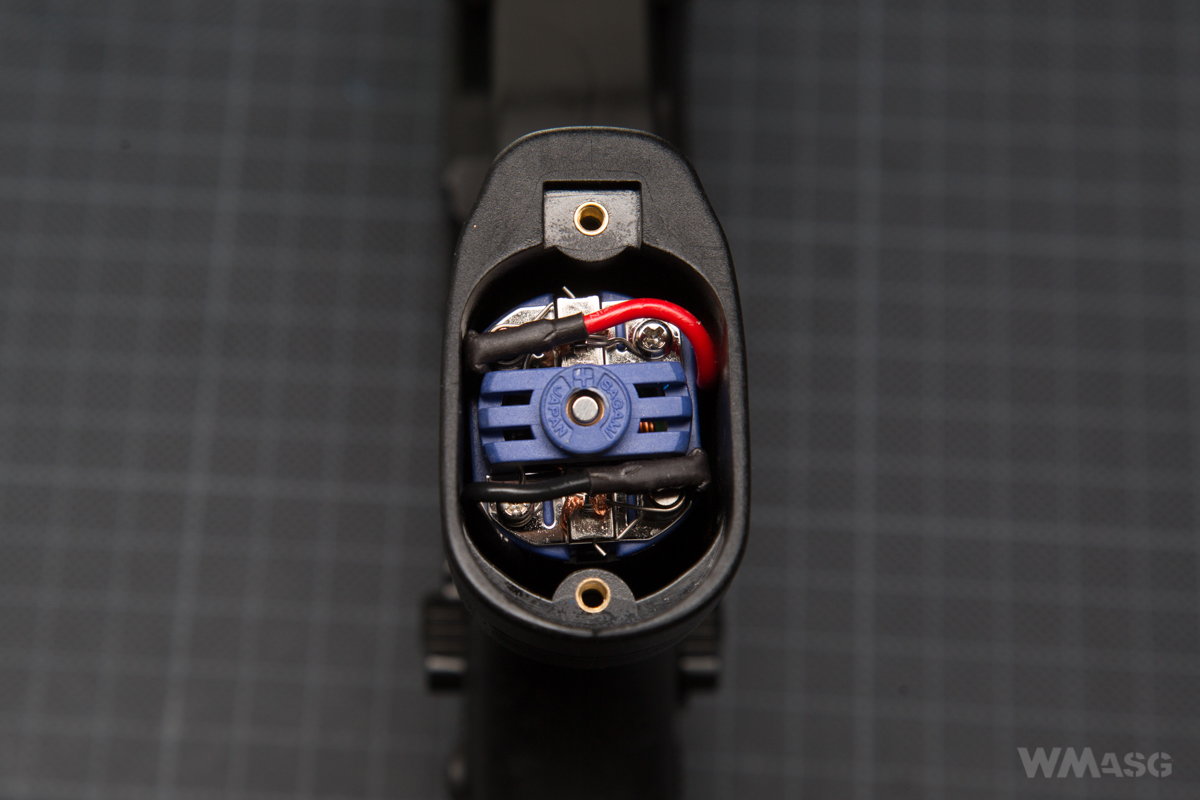
Finally, some more information about the gearboxes. The frames with and without EBB are not compatible. When looking for spare parts for your replica, pay attention to that detail.
The inner barrel and the HopUp chamber
The MARS DMR inner barrel has a length of 458 mm and, as in other CXP replicas, it is made of aluminum. It is light, black and very similar to Mad Bull's Black Python. ICS does not state the inner diameter of the barrel in any of its materials.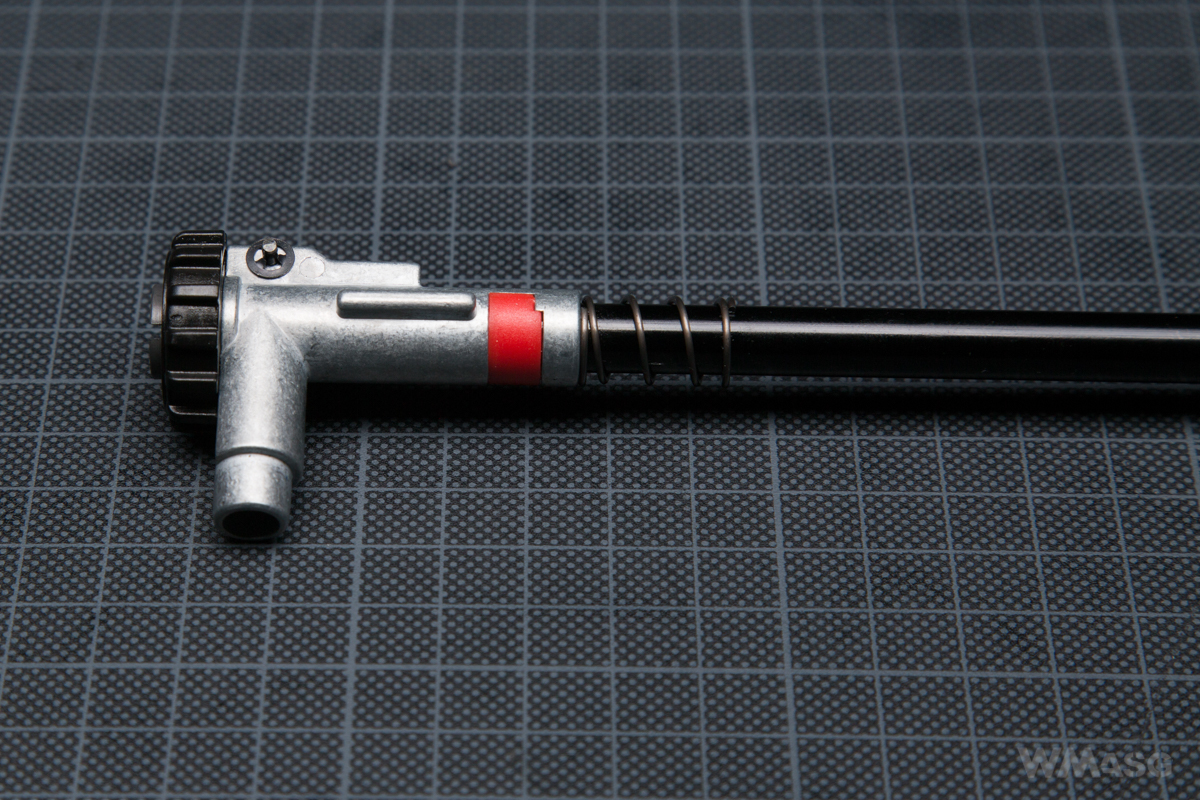
HopUp chamber is a one-piece design, made of ZnAl, with one adjustment knob mounted around the barrel's axis. By turning the adjusting ring downwards, we increase the HopUp system effect. But turning its up, we reduce it. The bucking and the spacer are standard.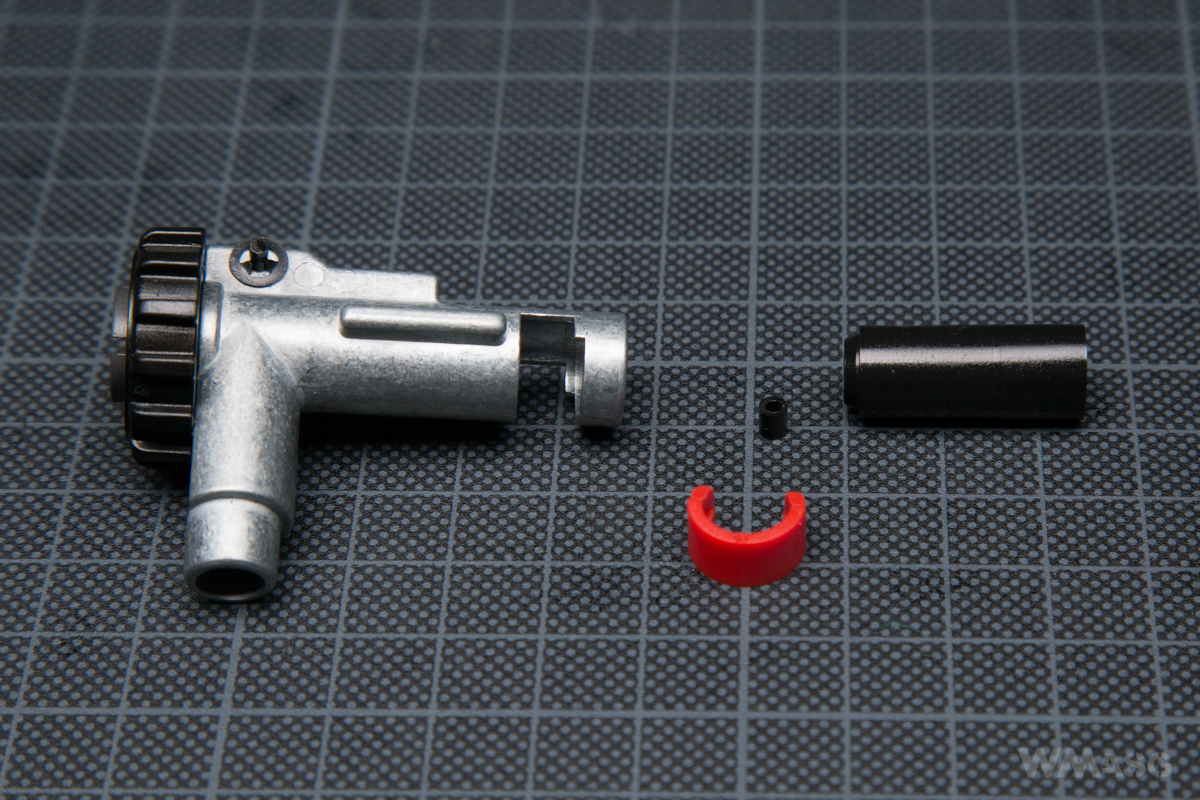 ATTENTION! The chamber does not fit in replicas without the blowback system.
ATTENTION! The chamber does not fit in replicas without the blowback system.
Target shooting test and muzzle velocity measurement
The test was carried out on our own enclosed shooting range, at an ambient temperature of 23oC, the Hop-Up was set to zero. The muzzle velocity measurements were made with the XCORTECH X3500 chronograph using 0.2 g BBs.
The target shooting test was done using 0.25 g BBs. Distance from the target was 25 m. The shooting was made using the K-Zone shooting rest.
Muzzle velocity measurements of the CXP-MARS DMR (458 mm long barrel)
1. 343.9
2. 340.6
3. 339.6
4. 340.4
5. 337.2
6. 334.4
7. 336.5
8. 335.9
9. 337.2
10. 337.1
Average: 338.28 fps
The measurement results indicate that, contrary to the markings on the packaging, we tested a unit equipped with a spring weaker than an M120. This is likely because the carbines are manufactured in 5 different specifications.
The measured rate of fire (using a LiPo 11,1 V 2400 mAh, 15C battery) was 21 BBs/s.
Target shooting
We fired 10 shots.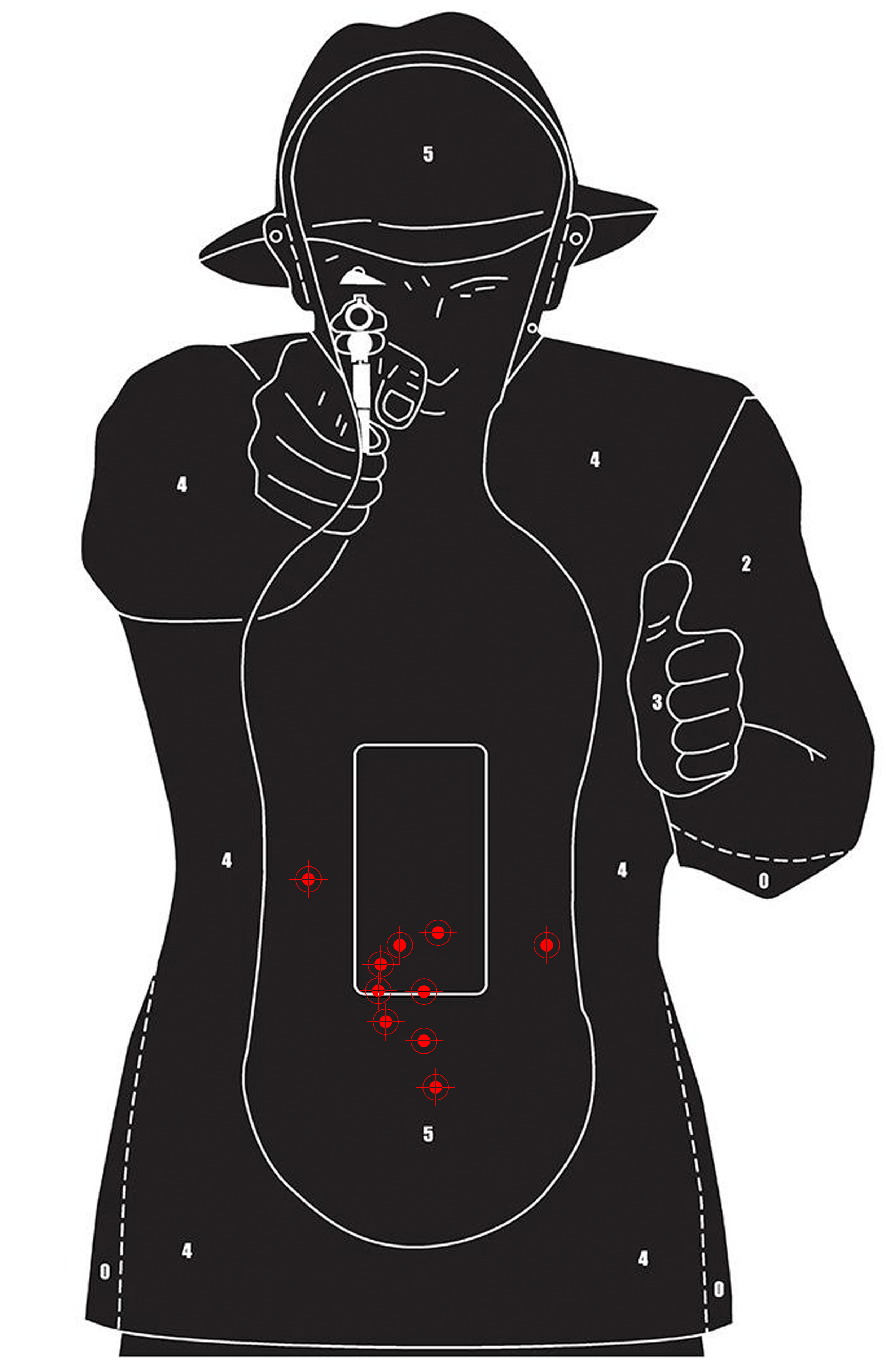
All shots hit the target. What widest spread between hits was 9 cm.
Summary
The whole MARS family are visually very attractive replicas. Not only are they manufactured very cleanly and very carefully bu they are also enriched with aggressive modern accents. Technically, apart from the factory-installed MOSFET or an optional electronic control module (which was not tested by us), there are virtually no fireworks, but we get above-average quality (durability) internal components. Having the ability to test several different ICS replicas simultaneously, we noticed this every time, even though the replicas came from different product lines.
The absolute difference between the AR rifle replicas made by ICS and those made by other companies is the possibility of an actual quick change of the muzzle velocity. In ICS replicas, as a rule, it is as fast as in the Systema PTW or the Katana EC, which were inspired by the former. There is no equally fast solution for the ARs available on the market. While in some ICS, and also in the case of the MARS series, we have two ways to choose from. One is to, after removing one of the pins, "unlatch" the guide and quickly replace the spring or simply replace the entire upper half of the gearbox.
Where is the catch? Some will probably be disturbed by slight play between the receiver parts. Others will point out a small supply of replicas and spare parts on the Polish market. In my opinion, however, the biggest problem for potential buyers will be a relatively high price, because the competition is not asleep and pushes harder and harder. Will ICS innovations be enough in the long run?

